How to Use LinkedIn Sales Navigator to Generate Leads in 2024
But let’s be real—figuring out how to use LinkedIn Sales Navigator properly isn’t always smooth sailing.
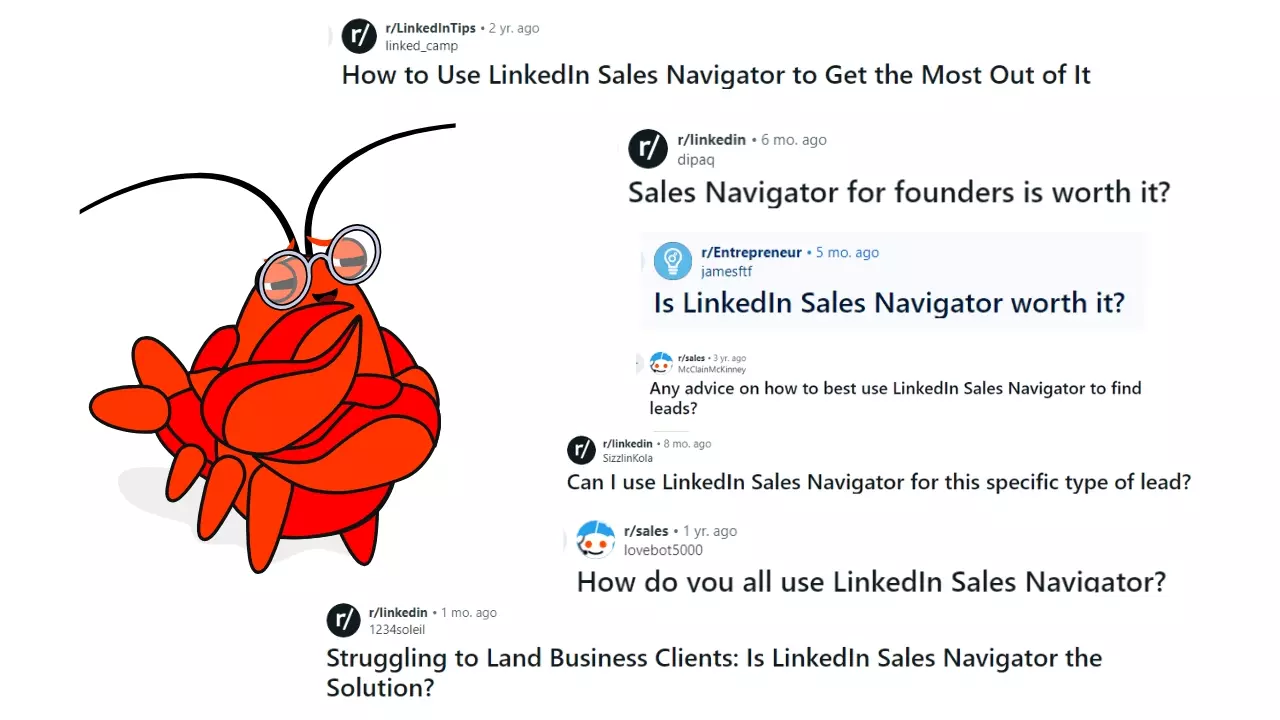
With so many features and complex filters, it’s easy to feel lost. That’s exactly why I'm writing this guide.
In this article, I’ll walk you through everything you need to know to get the most out of Sales Navigator without breaking a sweat.
I’ll cover:
- How to use advanced search filters?
- How to do boolean search in Sales Navigator?
- How to use Lobstr.io to get the most out of LinkedIn Sales Navigator
- How to reach out to your Sales Navigator leads?
- Problems and limitations of Sales Navigator
- Common mistakes people make while using Sales Navigator
But what about peeps who don’t know what Sales Navigator is?
What is LinkedIn Sales Navigator?
Sales Navigator is LinkedIn's premium tool to help you find leads, build connections, and close deals faster.
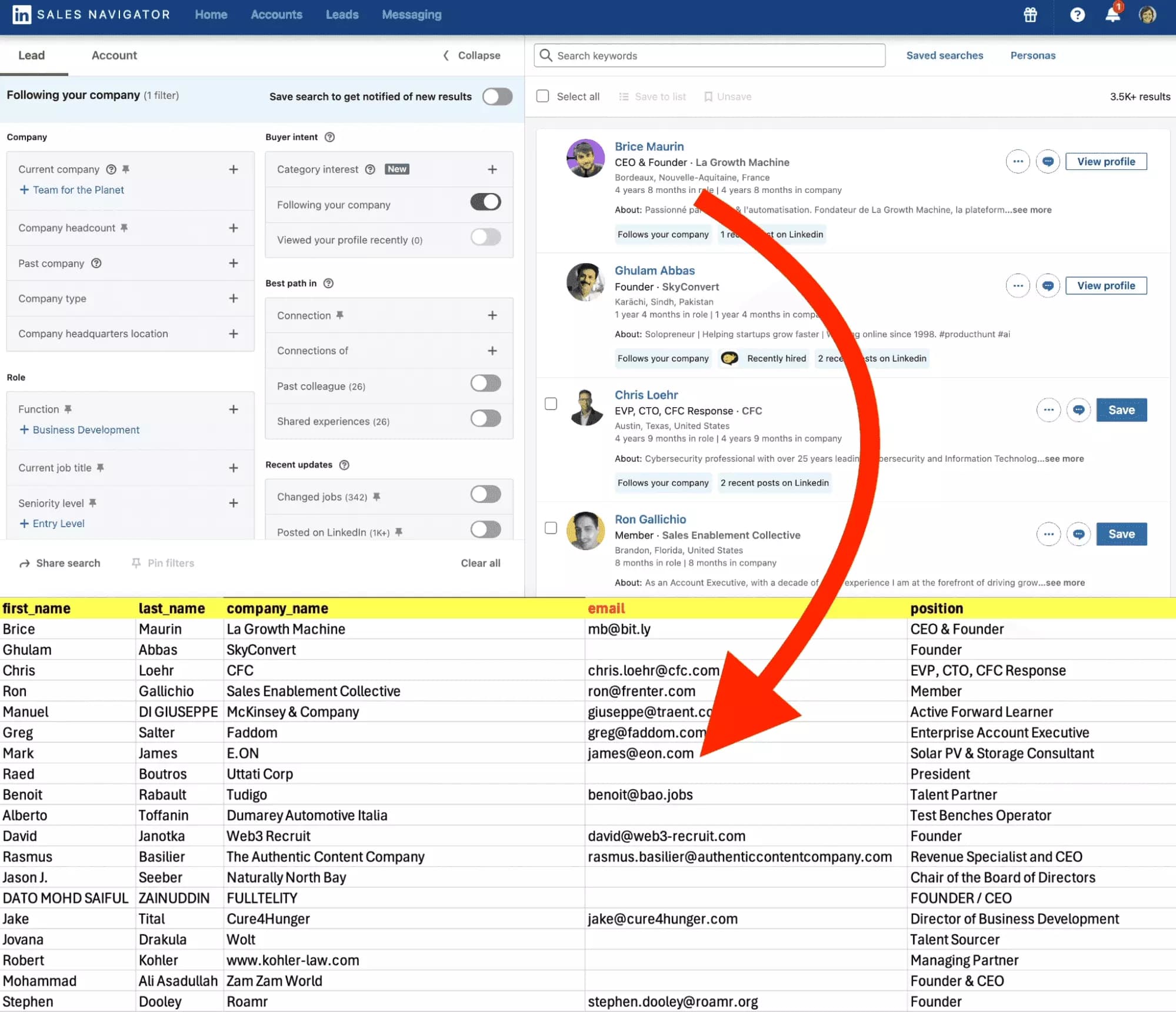
It uses real-time data and insights to help you connect with the right people at the right time, making your outreach smarter and more effective.
But is it really a good investment for prospecting?
Why Use LinkedIn Sales Navigator for prospecting?
Sales Navigator is designed to fit different roles to streamline their outreach, engage with the right people, and manage their leads effectively.
- Sales professionals use it to find decision-makers fast
- Marketers use it for high-value prospecting and ABM campaigns
- Business owners use it to discover new clients to build long-term relationships
- Sales teams use it for warm introductions and shared leads
But is it worth using for lead generation?
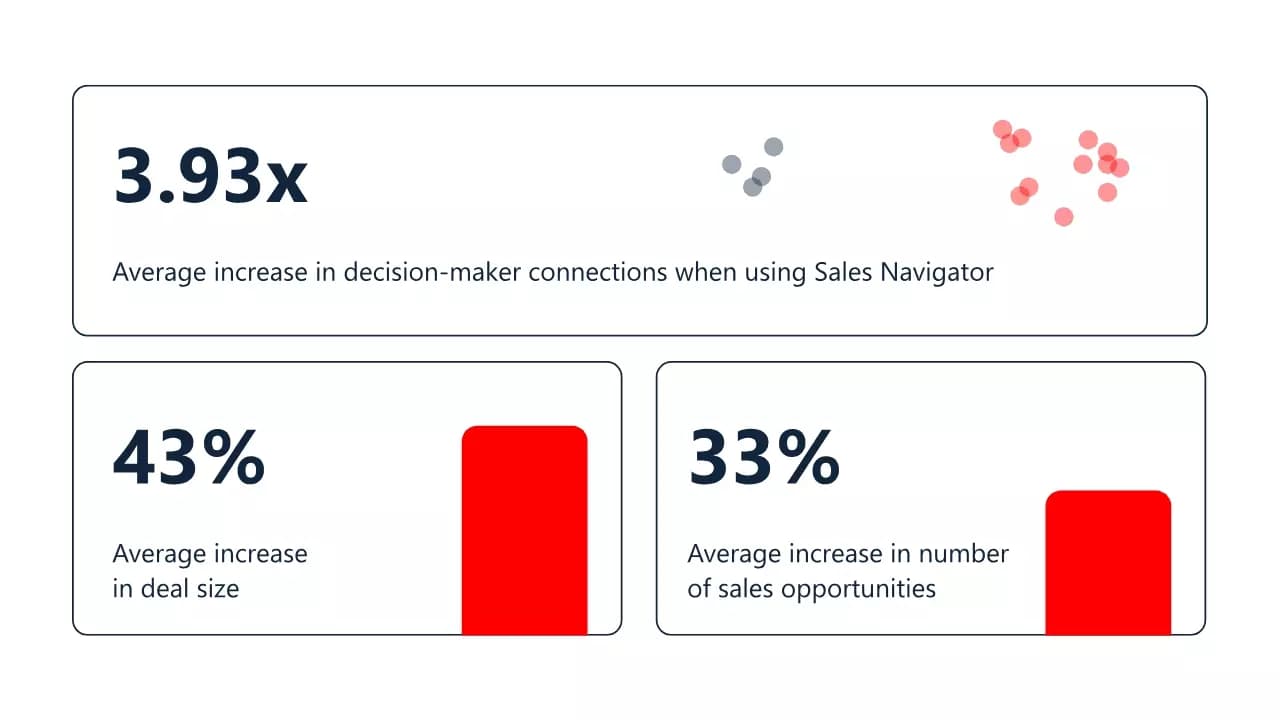
- 8% revenue growth on average, each year
- 15% increase in sales research efficiency
- 312% return on investment in three years
- 4x more connections with decision-makers
But how much does it cost?
How much does it cost to use LinkedIn Sales Navigator?
LinkedIn Sales Navigator offers 3 subscription plans, each with its own unique set of features.
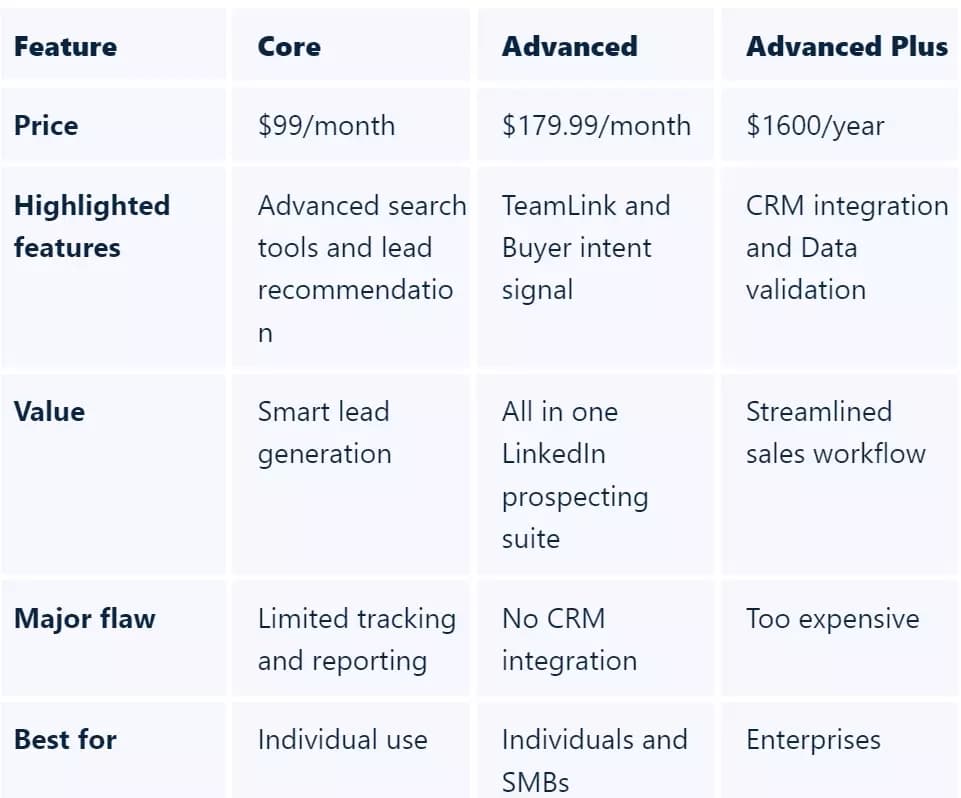
- Core plan costs $99 per month and is best for lead generation
- Advanced costs $180 per month and offers team management features
- Advanced Plus starts at $1600 per year and offers CRM integration
Which plan is best for you?
For lead generation, the Core plan works fine. It has all the features you need for smart prospecting.
If you have a sales team and need features like reporting and accessing team’s connections in Sales Navigator, you can go for the Advanced plan.
If you want to integrate Sales Navigator to your CRM system like Hubspot or SalesForce, that’s possible only if you buy the Advanced Plus subscription.
Check it out for a detailed breakdown and choose the best plan that suits your requirements.
But what are the key features of Sales Navigator that make it so useful?
Key features of LinkedIn Sales Navigator for prospecting
Sales Navigator is like a complete suite for prospecting and managing sales pipelines. Here are some key features it offers categorized by use case.
| Prospecting | Engagement | Management |
|---|---|---|
| Advanced search filters | InMail | CRM integration |
| Saved searches | Smart links | Usage reporting |
| Relationship explorer | Real-time alerts | Data validation |
| Relationship map | TeamLink | ROI reporting |
| Lead recommendations | Buyer intent signals | |
| Account IQ | ||
| Account hub |
Let me elaborate the key features of Sales Navigator you’d need for lead generation.
How to use LinkedIn Sales Navigator for lead generation
I’ll main features from the prospecting category because prospecting tools are what we actually need for lead generation.
Let’s start with filters.
How to use advanced search filters?
First perk of Sales Navigator is that there’s no search limit. Unlike LinkedIn basic, where you can only search 300 profiles, Sales Navigator has no search limits.

Another key feature which makes it a champion of lead generation is – advanced search filters.
LinkedIn offers 50+ advanced search filters to find the right leads quickly by narrowing down searches with precision.
There are 4 types of advanced filters in your Sales Navigator search window.
What are lead filters in Sales Navigator?
Lead filters help you find individual people you want to connect with, like decision-makers or key contacts within a company.
You can filter by things like job title, seniority, location, and experience to get super specific about the people you want to target.
Lead filters are further divided into categories:
- Company
- Role
- Personal
- Buyer Intent
- Best path in
- Recent Updates
- Workflow
In company filters, you can target leads based on their current company, company type name, headcount, headquarter location, and even past companies.
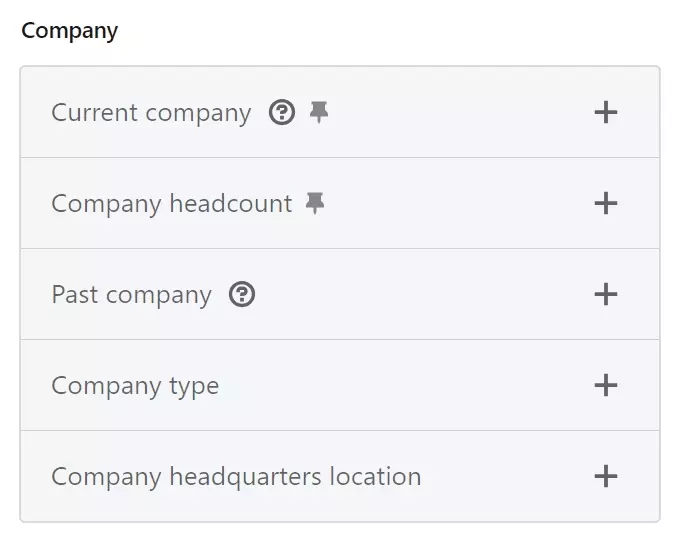
Related to company filters, you have to role filter.
The role filter has options like current and previous job role, function in current role, years in current company and role.
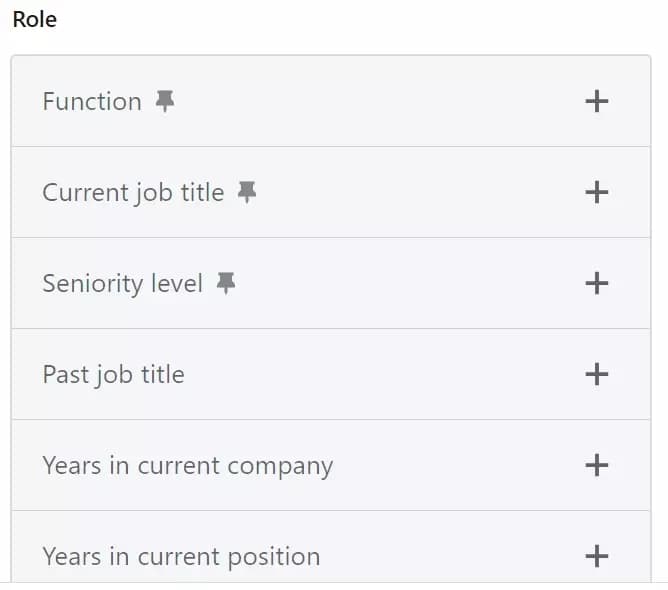
To find decision makers or important people, it’s best to use these filters combined.
For example, I can use this filter to find co-founders of small businesses who have worked at IBM previously, based in the US.
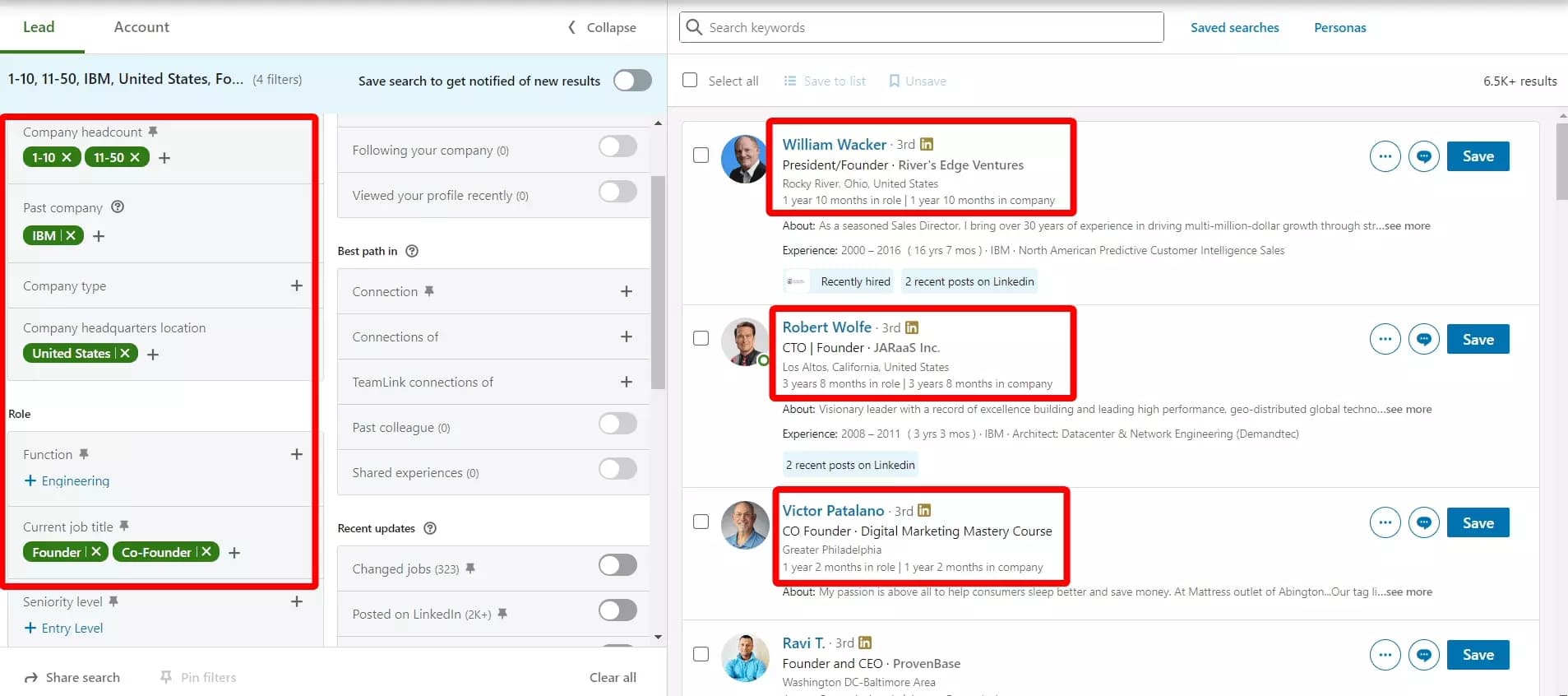
But what if I want to filter founders who have recently started the new venture?
That’s where the results mismatch.
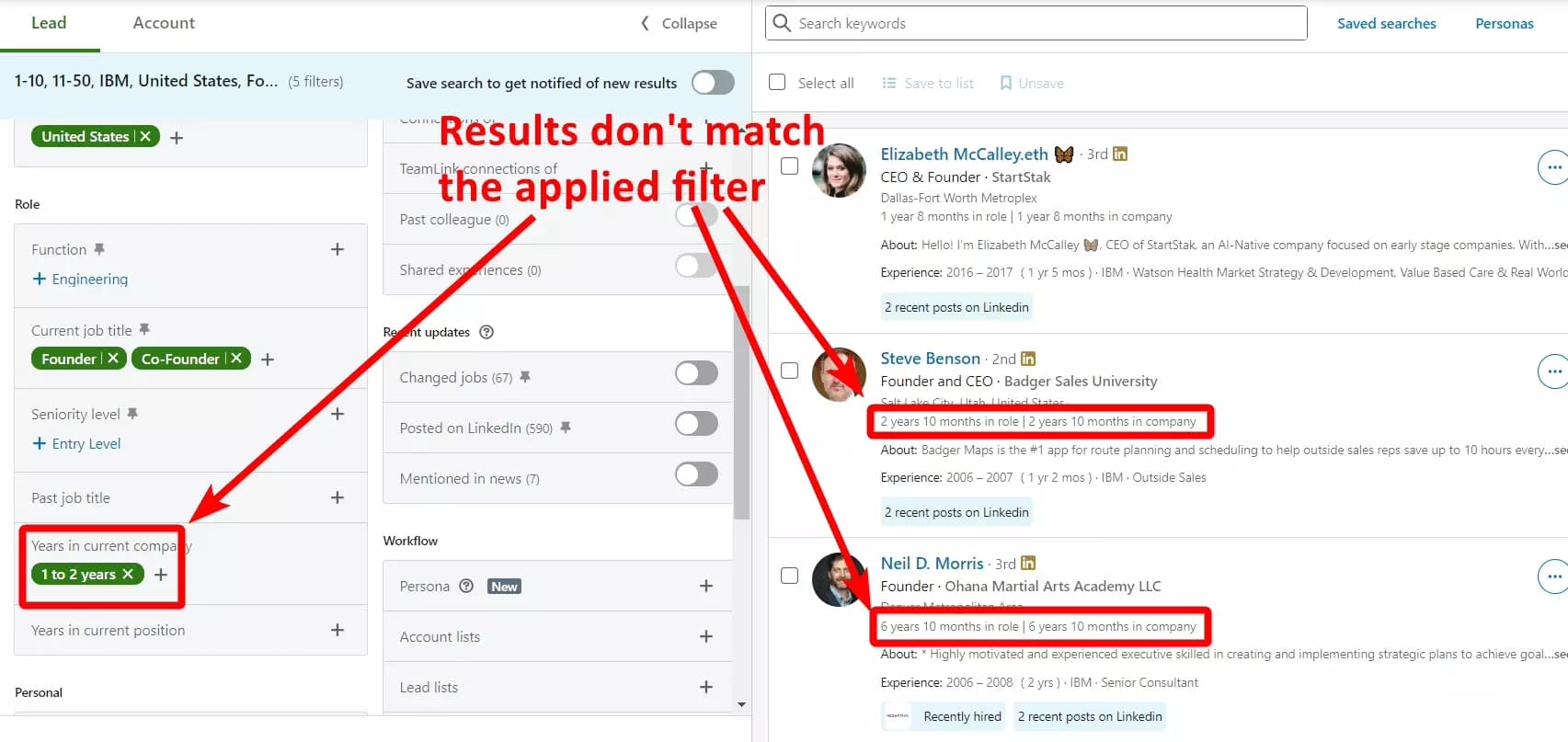
Sales Navigator starts giving you mixed results like random experiences, random years in company.
To fix this, you can use both years in current position and years in current company filters together.
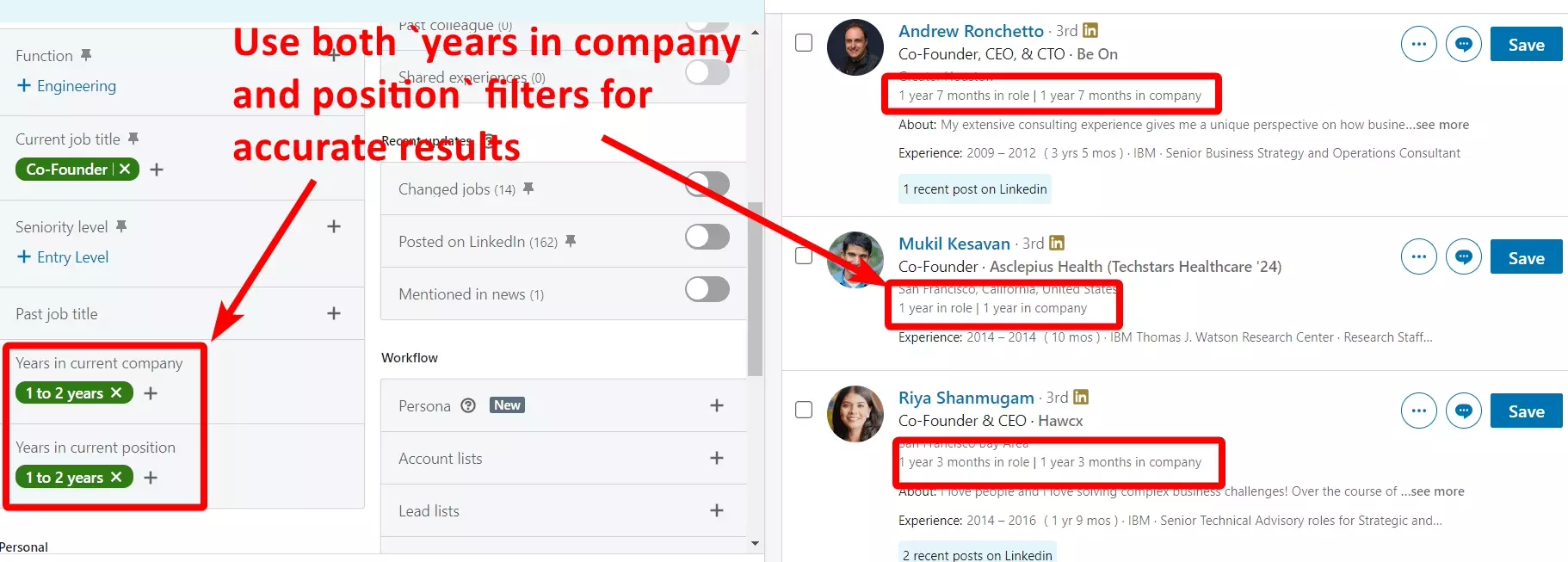
Also, be careful while using seniority level and current job role together. It might give you random results.
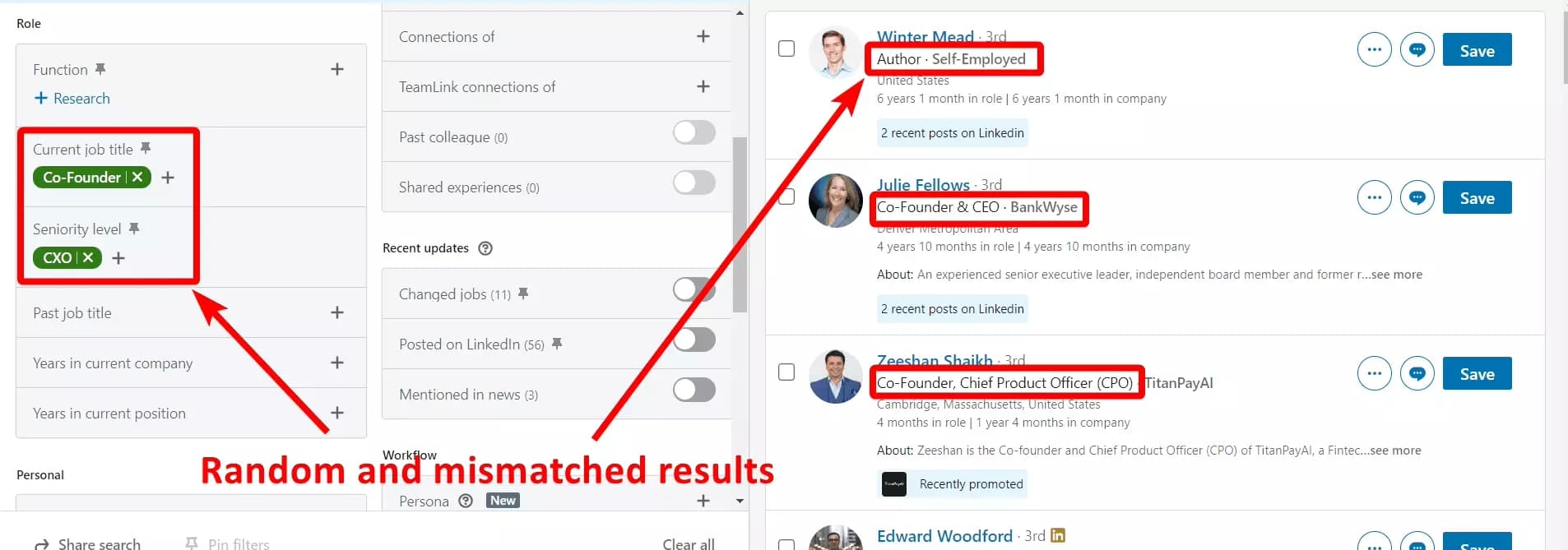
It does give correct results for certain seniority levels like director and owner/partner. For others, the results are mostly mismatched.
The better way to use the seniority filter is with the function filter. This will help you discover new job roles and also provide accurate results.

But even this can backfire sometimes.
In personal filters, you can choose demographics of a potential lead like geography, industry, years of experience, language, education etc.
You can use the personal filters independently or for precise results, combine them with role filters.
For example, I can combine these filters to find people working in the finance industry at VP level, specifically those who went to Harvard University.
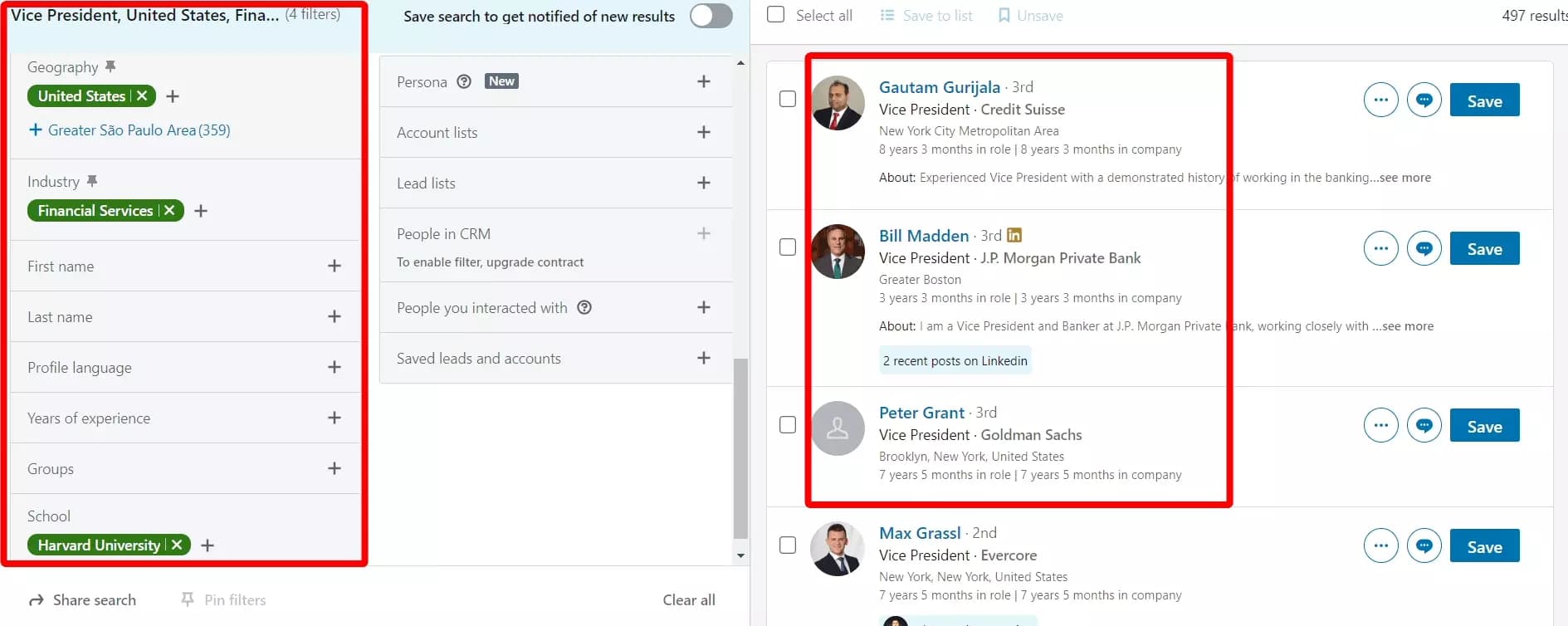
But be careful with the industry filter.
Sales Navigator doesn’t fetch the industry of the company your prospect works for. It gets industry data from the user's profile.
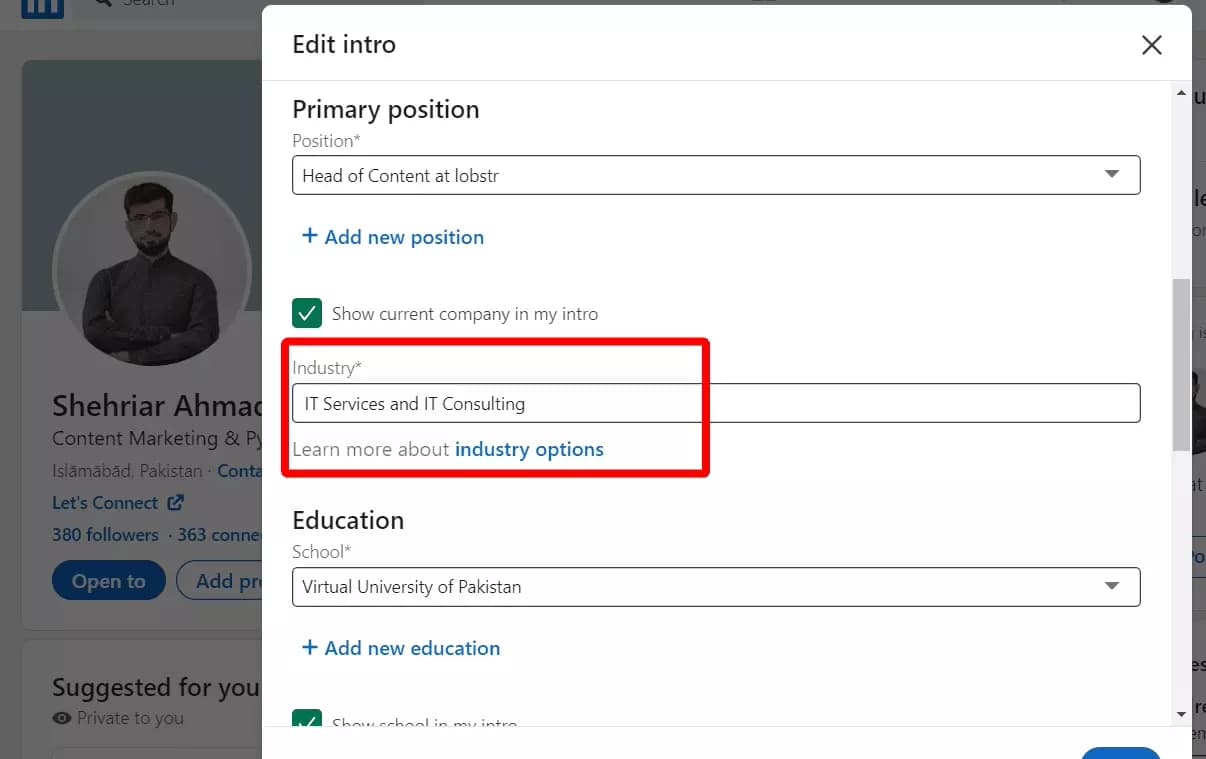
If the user’s industry is different from the company's industry, you might get wrong results.
You can also use the years of experience filter for more precision.
The first and last name filters didn’t seem useful to me.
The buyer intent filters help you find leads most likely to respond to outreach or express an interest in your product or service.
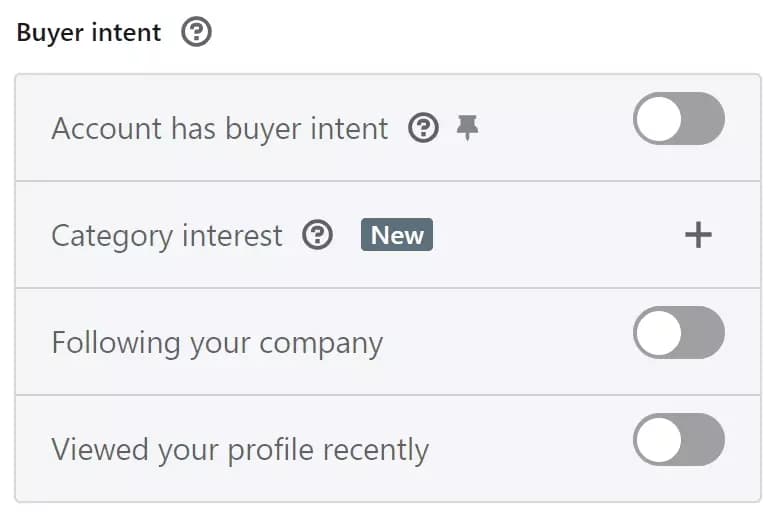
The account has buyer intent feature highlights leads working at companies that have shown high or moderate interest in your business over the last 30 days.
LinkedIn collects this data by tracking their engagement with your InMails, ads, company page views, and profile views.
Category interest highlights leads who might be interested in your product category. It pulls data from things like group memberships and profile info.
But these filters are not reliable.
For example, I searched for prospects interested in data extraction software, the results are mostly people who work at similar companies.
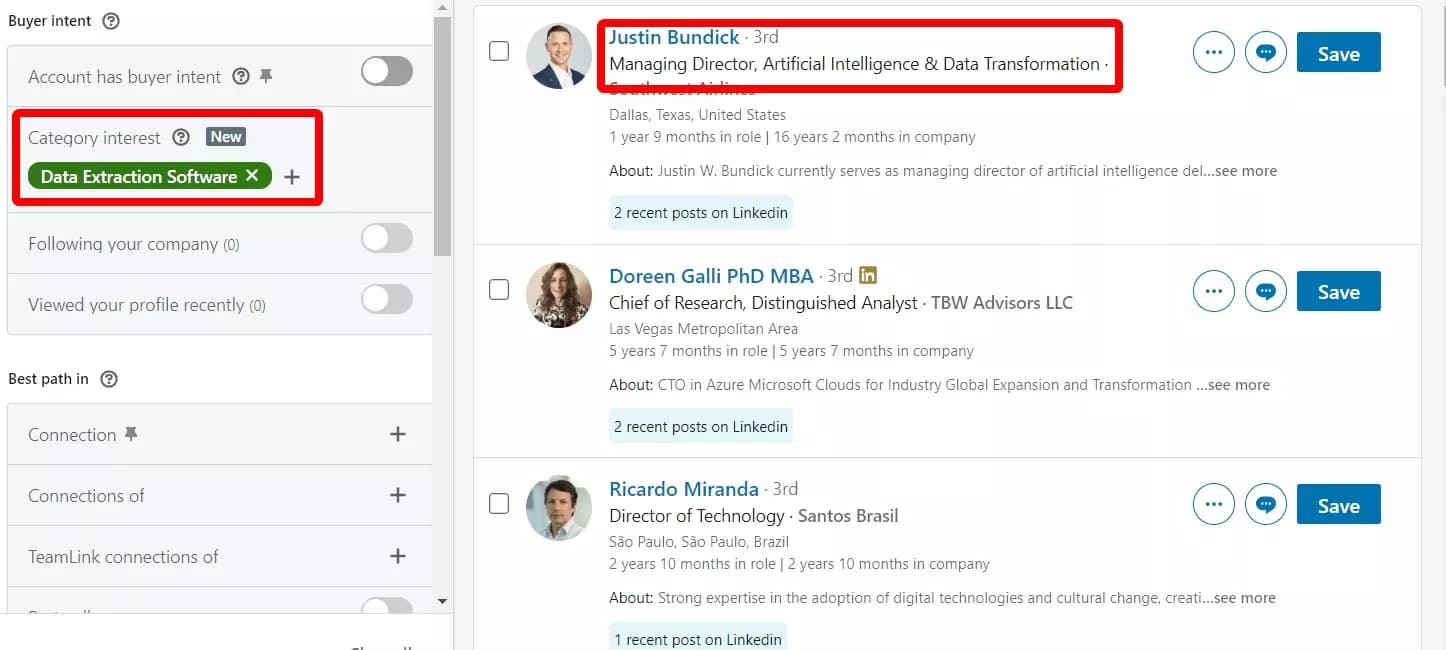
But there’s a great way to make this filter useful. Combine it with the industry and current job role filters and see the magic.
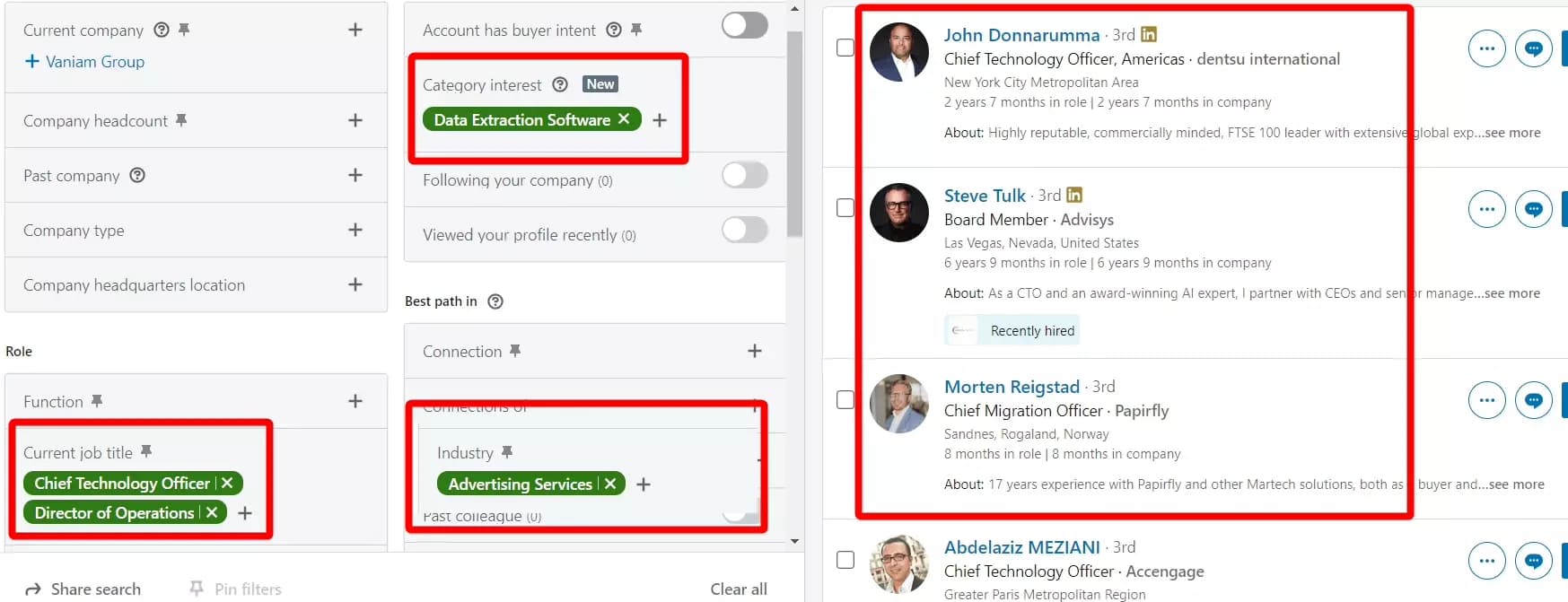
It might not be super accurate but the results are better and valuable.
Followed your company and recently viewed your profile filters are self explanatory and I got zero results, so skipping them.
The Best Path In feature helps you find the easiest way to connect with a company using your network.
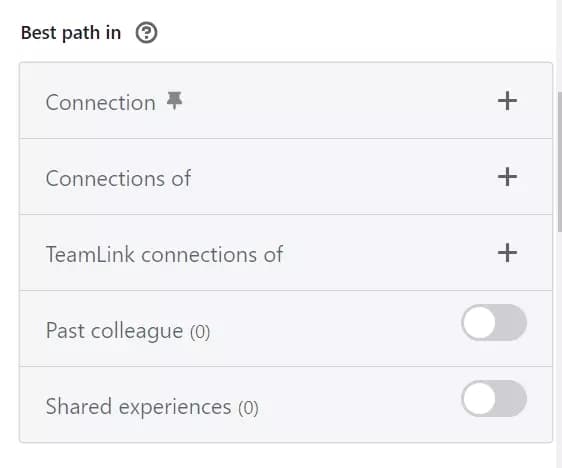
You can use this to find your 1st, 2nd, 3rd degree connections, connections of your connections, group members, and TeamLink connections.
TeamLink helps you access your coworkers’ connections. If you’re not directly connected to someone, TeamLink shows you if any of your coworkers are connected to that person.
Recent updates filter is my favorite feature of Sales Navigator.
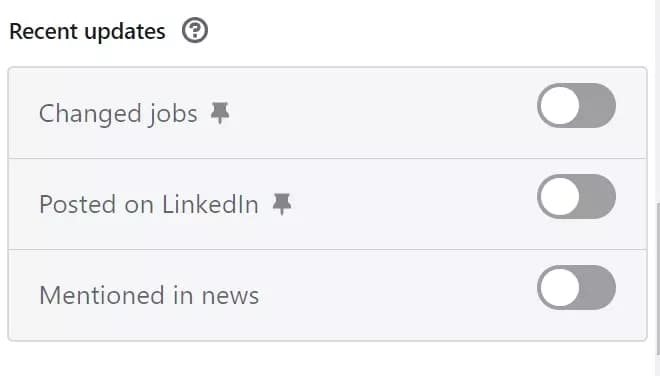
This filter can help you precisely target prospects who have had switched roles or companies in the last 90 days.
You can filter people who have posted anything on LinkedIn in the last 30 days or mentioned in the news over the past 90 days.
This data can help you build a connection and act as conversation starters. You can mention them in your first interaction as ice breakers.
Combining changed jobs with other 2 filters can help you get an idea of why the potential lead went for a job change, which can be valuable information.
Workflow filters help you focus on leads and accounts already part of your sales process.
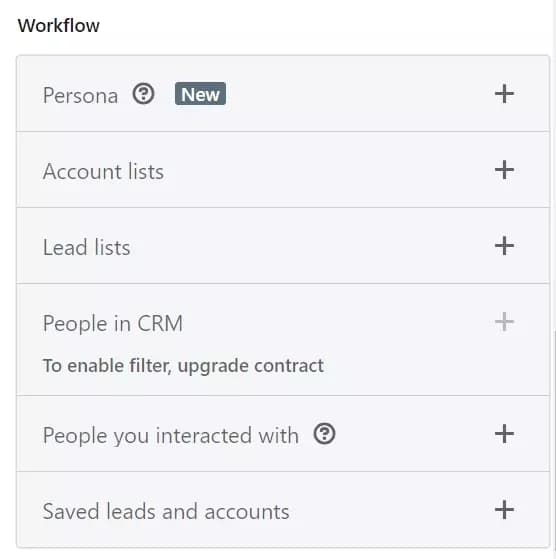
You can target leads based on specific personas you have created.
You can create new personas by specifying your potential buyer’s geography, seniority level, job title, and function.
With accounts and leads lists you can focus on the leads or accounts you’ve already saved in Sales Navigator.
If you have an Advanced Plus subscription, you can import contacts from your CRM as well.
Workflow filter also allows you to target people you’ve interacted with, like those who replied to your InMails or interacted with your content.
Then we have account filters.
What are account filters in Sales Navigator?
Account filters allow you to target account pages (companies) that fit your ideal customer profile.
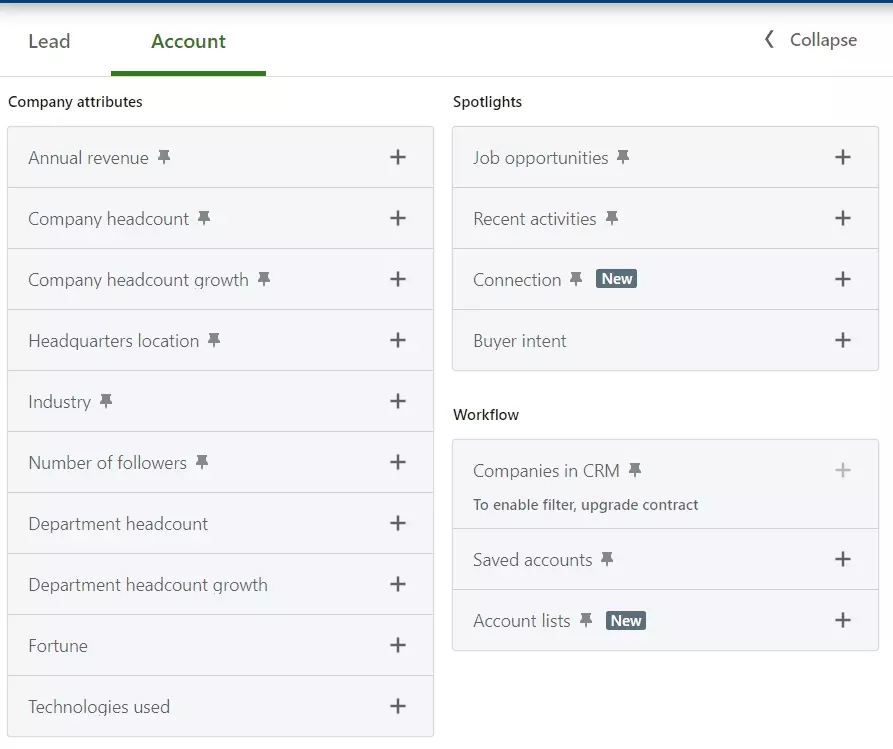
Instead of individual leads, these filters help you search for companies.
You can use them for account-based marketing and job hunting.
But what about lead generation?
You can use account filters for lead generation too.
The company attribute filters can help you narrow down companies that fit your ideal customer profile.
For example, I can use them to find advertising companies, based in California, with less than $500k annual revenue.
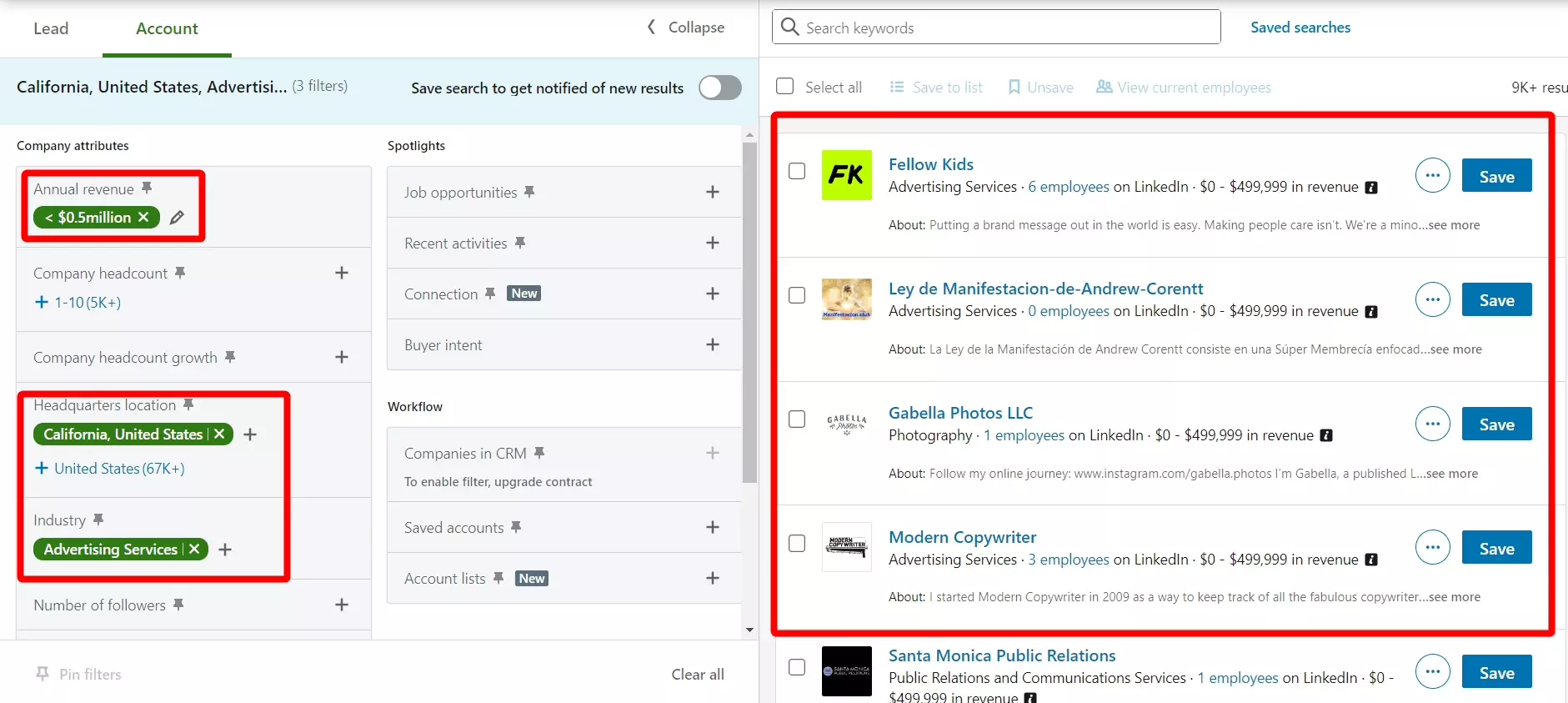
Once I have the companies that might be interested in my product/service, I can save them to an account list and then use lead filters to find decision makers.
You can further narrow down your search by department growth, headcount growth, and technology used.
But be careful with the technology filter.
It doesn’t always work as expected as there’s no information available on how LinkedIn gets the technology.
For example, when I searched for companies that use WordPress, the results were mostly accurate.
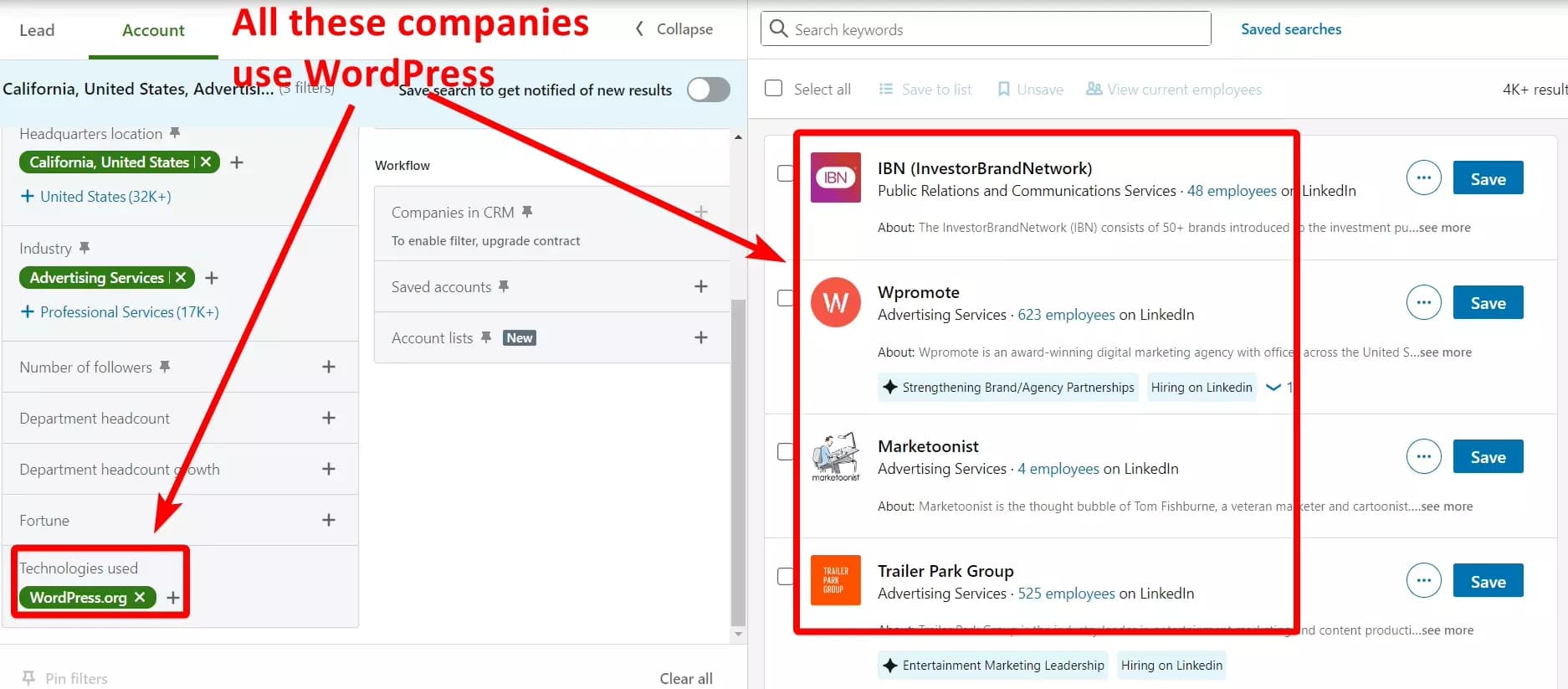
But when I tried Shopify, the results were a big time mess.
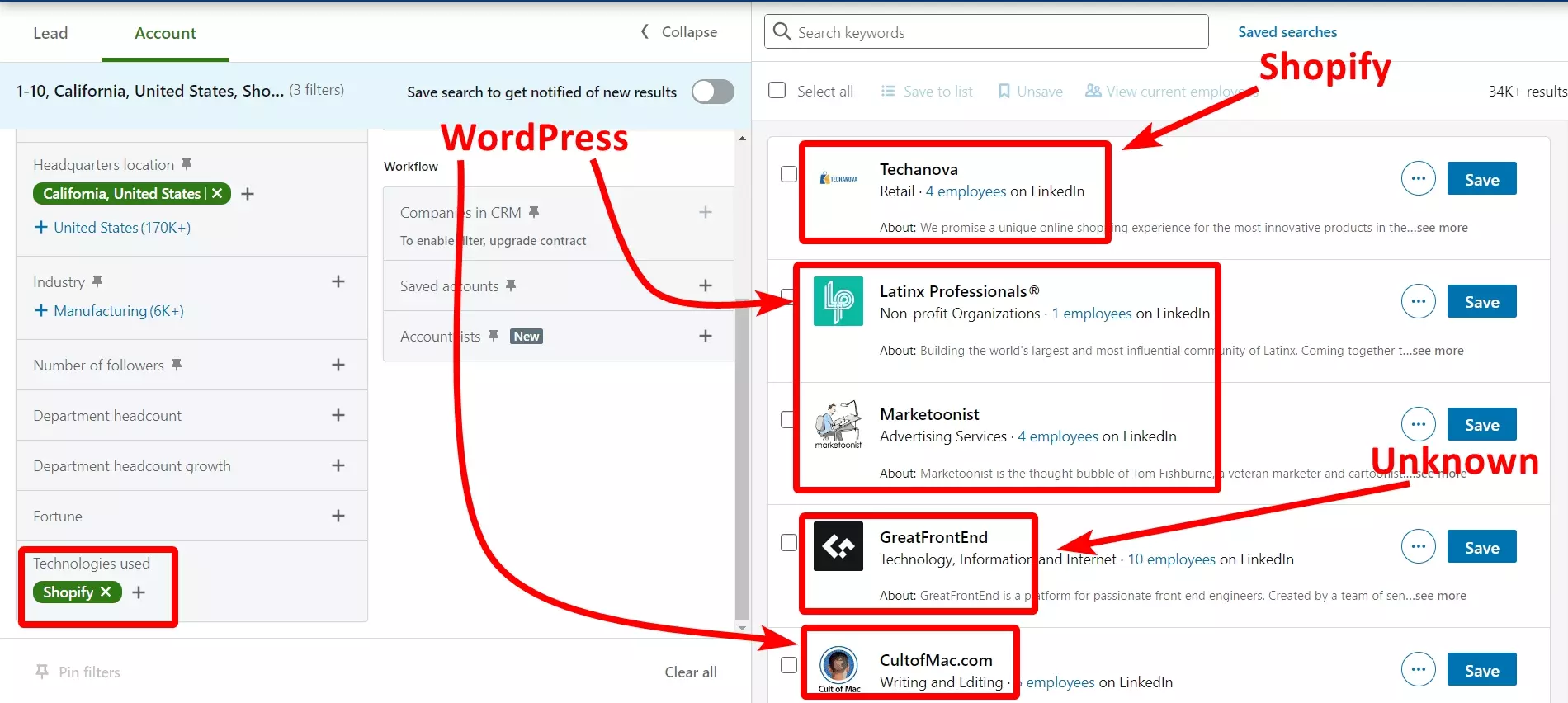
Though I didn’t find any method to get accurate data, the filter worked well with WordPress related technologies, wix, and squarespace.
Rest of the filters are not useful for lead generation, so skipping them.
Then we have another awesome feature in Sales Navigator search – the exclusion filter.
What is exclusion filter in Sales Navigator?
The exclusion filter allows you to remove certain companies or leads from your search results.
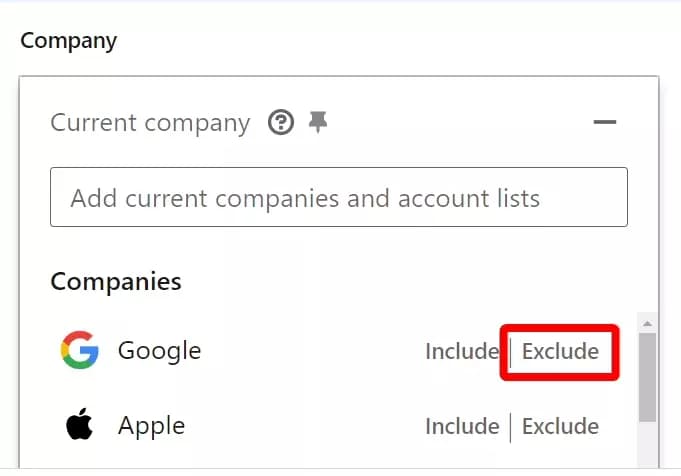
You’ll find this option in the following filters:
- Company
- Geography
- Seniority
- Title
- Industry
You can use it to remove competitors or client companies or leads from appearing in your search results.
For example, I don’t want Lobstr.io’s competitor companies in my lead search. I can exclude them using this feature.
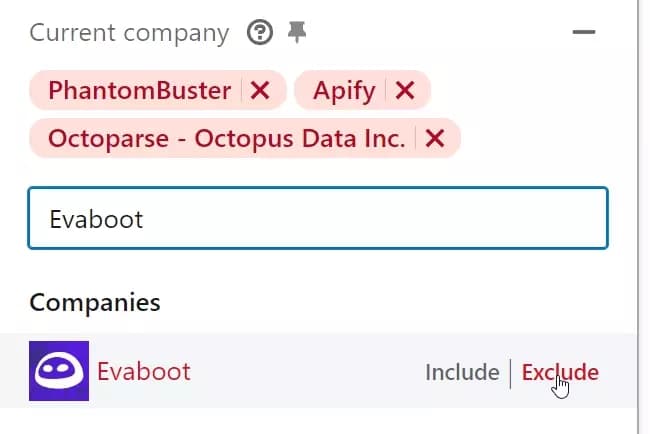
But what if I want to hide them from all searches? Excluding them every time is extra effort.
To solve it, I can add them to a new account list and then exclude them from workflow.
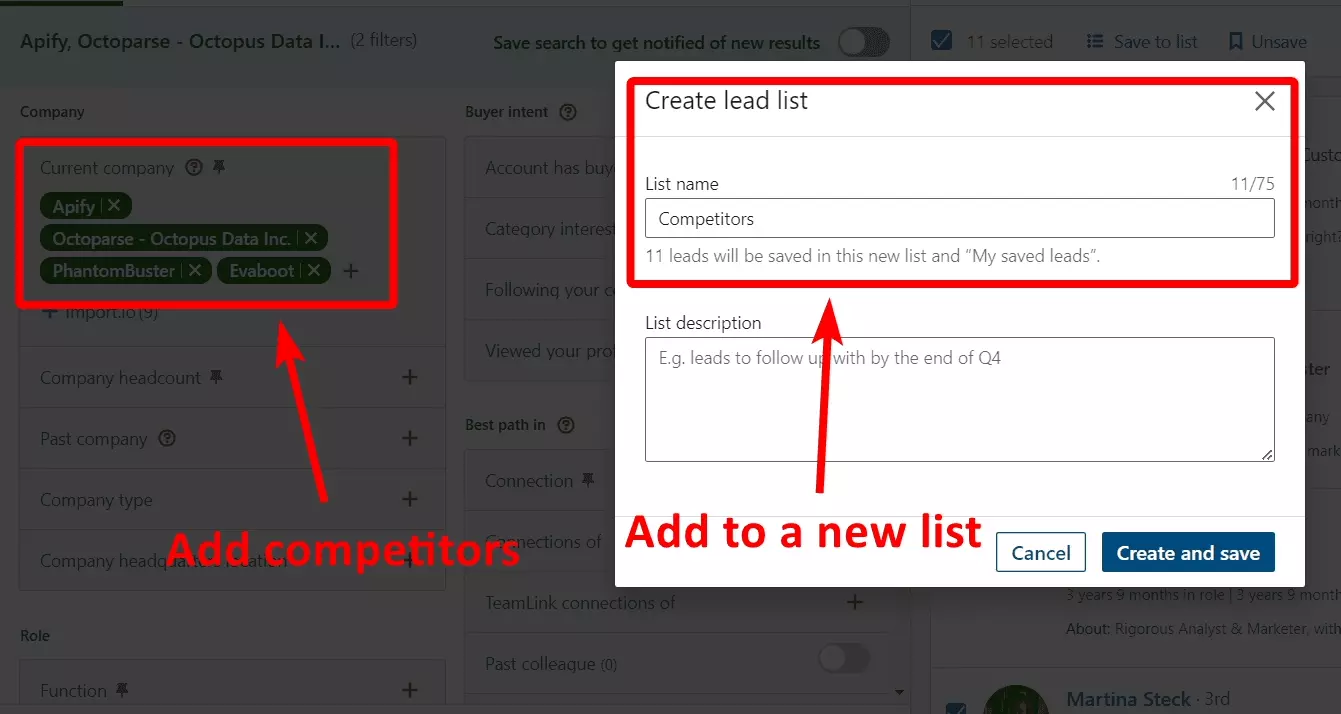
Now simply go to workflow and in lead or account lists, exclude this list.
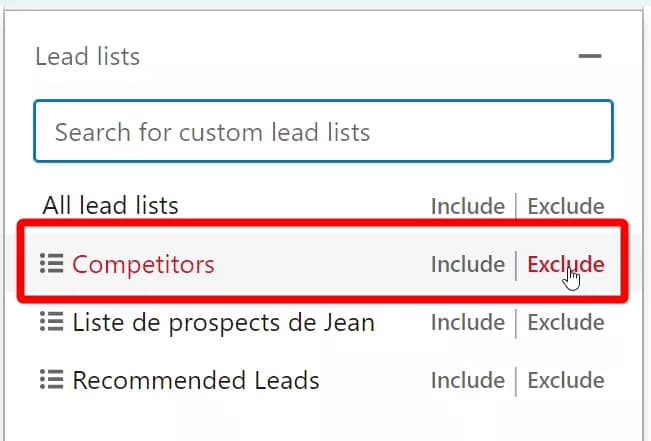
Now let me tell you about the coolest feature of Sales Navigator – boolean search.
How to do boolean search in Sales Navigator?
A simple search in Sales Navigator looks like this:
Boolean search is a way to make your search more precise by using special words and symbols.
In Sales Navigator, it helps you find exactly who you're looking for by combining different keywords to narrow or expand your search.
Here are the operators (keywords and symbols) you should remember while doing a boolean search on Sales Navigator:
- Quotes – Finds exact phrases in the results (e.g., "Marketing Manager")
- AND – Shows results that match both keywords (e.g., "Marketing AND Manager")
- OR – Shows results that match either keyword (e.g., "Sales OR Marketing")
- NOT – Excludes specific keywords from your search (e.g., "Engineer NOT Junior")
- Parentheses – Combines multiple Boolean operators (e.g., "(Marketing OR Sales) AND Manager")
Let’s see them in action.
You can use these operators in both keyword search and job title search options.
Using Quotes and Parentheses
Quotes limit your search results to profiles containing the exact phrase you searched for.
For example, if I have to find profiles of prospects who are both co-founder and CEO at their company, I can do it using Quotes.
Example: "I am co-founder and CEO"f

But if you want to search job titles or positions, using quotes in keyword search is not a good idea.
With quotes in the keyword search bar, LinkedIn shows results that contain the exact phrase anywhere in the profile (past experience, description, education, etc.)
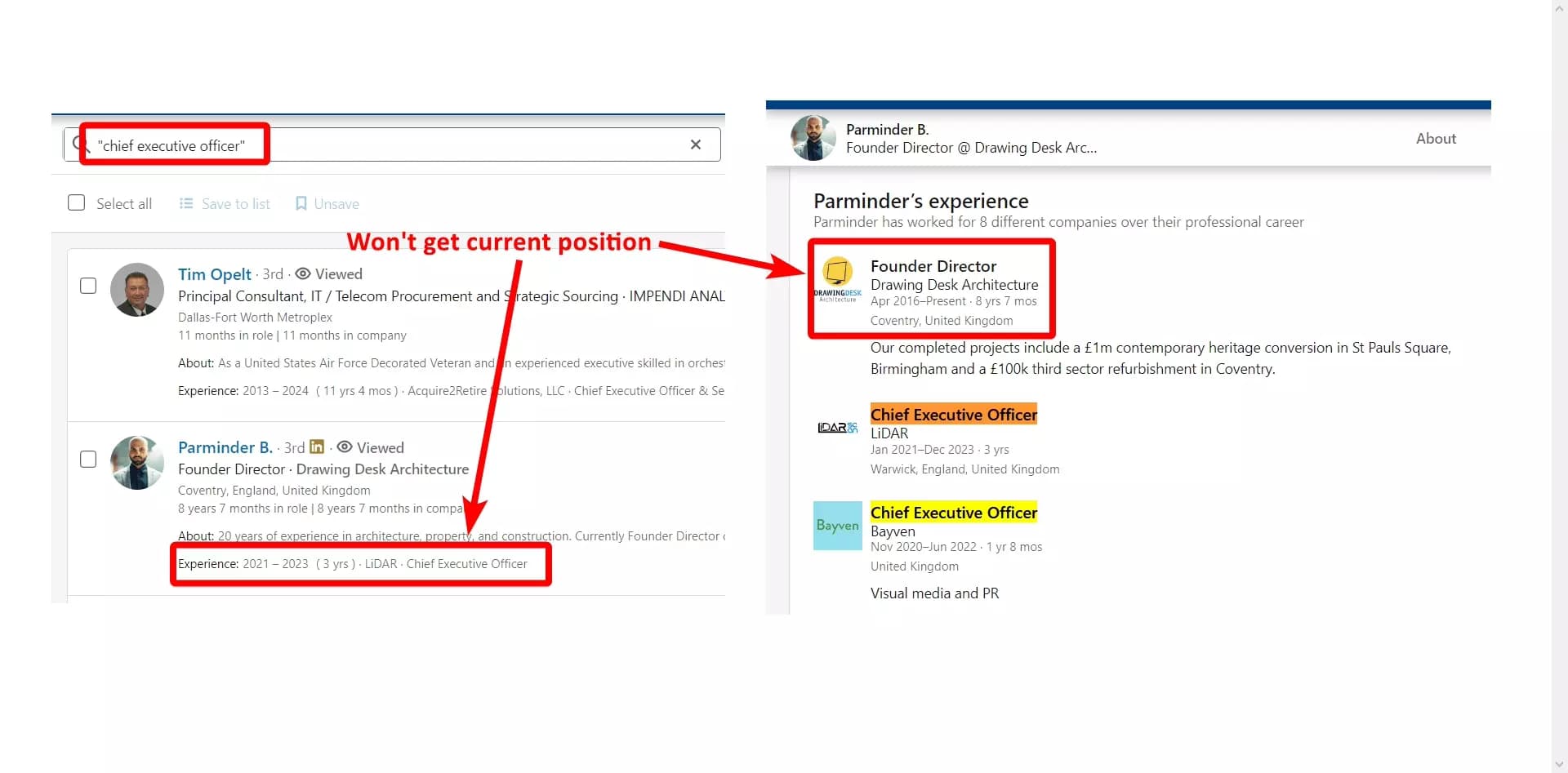
The better way to find exact match job titles is using quotes in current job titles search.
For example, here I wanted to find a specific job title so instead of choosing predefined titles, I added a boolean query.
Example: "Head of product development"f

You can use parentheses to combine multiple searches and control how they’re processed.
I’ll use them in examples of each boolean operator.
Using AND operator
You can use AND operator to search for profiles with an exact match of 2 or more phrases you specify.
Example: "Marketing AND Sales"f
You usually don’t need the AND operator because as a standalone operator, it’s not effective.

But it’s pretty effective if used to combine 2 queries.
For example, I want to find leads who are in marketing and are also at manager level.
Example: "(Marketing) AND Manager"f
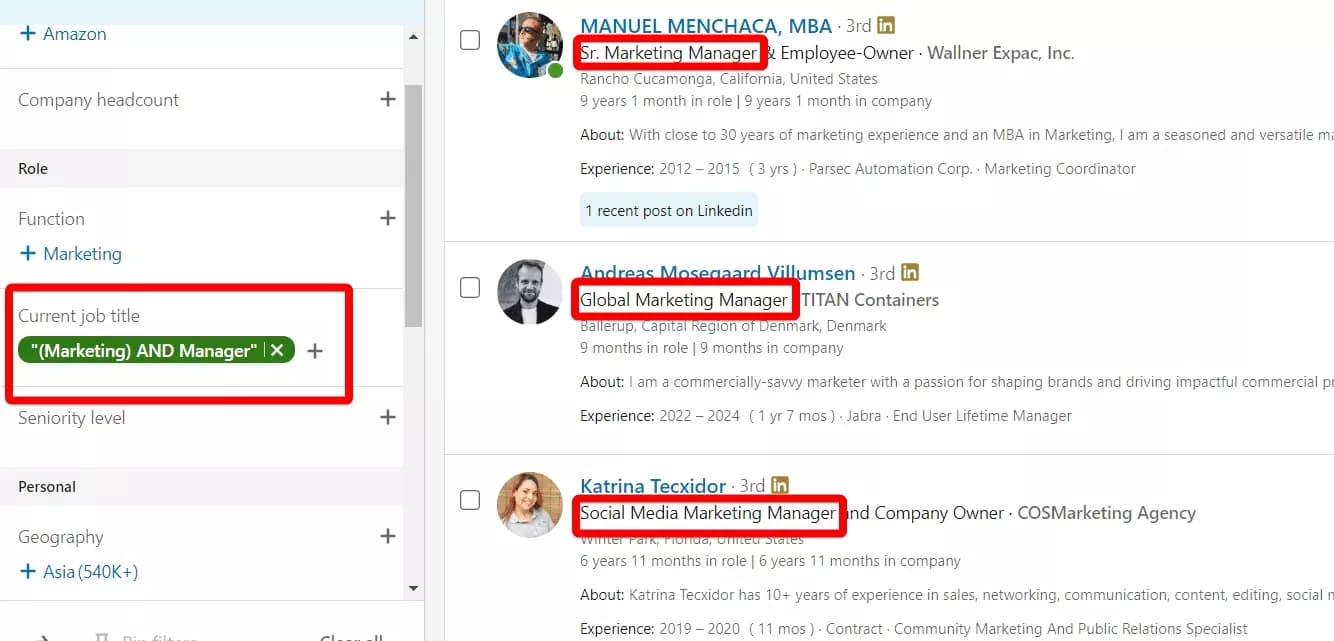
Another operator you can combine with AND to narrow/limit search results is NOT.
Using NOT operator
You can use NOT to exclude certain keywords from your search.
For example, I want to target marketing people who are managers but I don’t want to target social media marketing managers.
Example: "(Marketing AND Manager)" NOT Social Mediaf
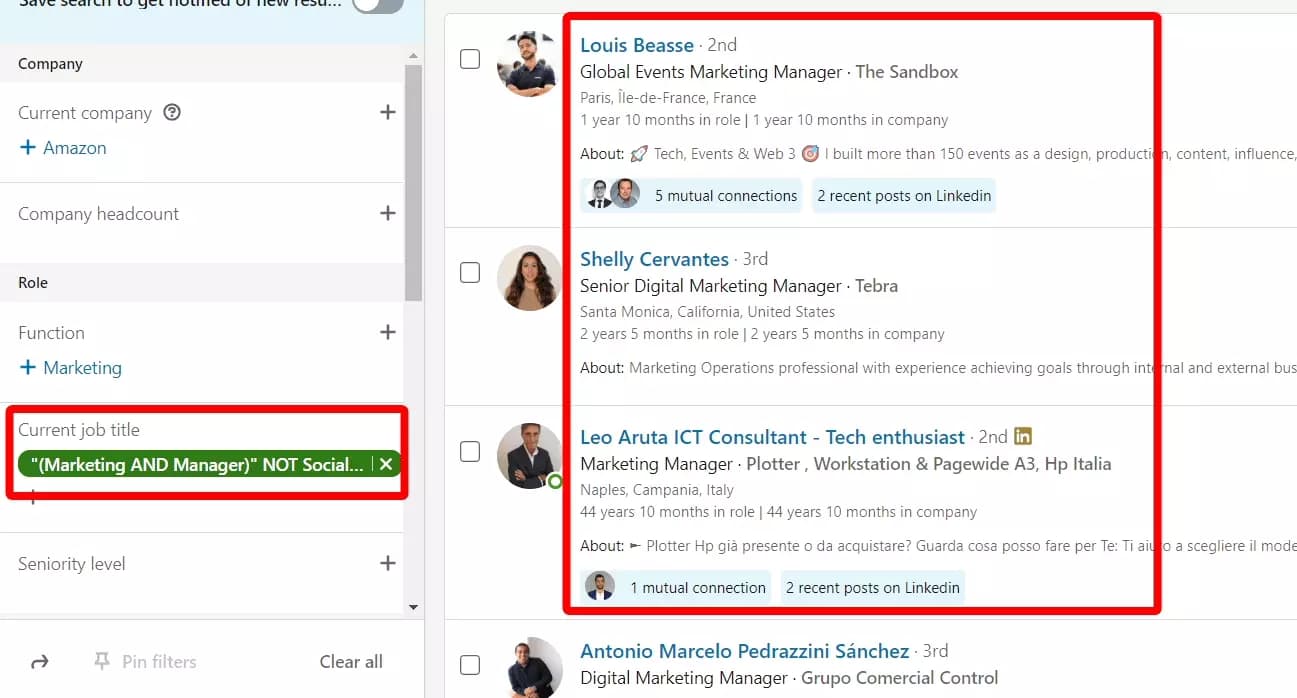
Make sure to keep the NOT keyword outside quotes or LinkedIn will ignore NOT and include all results.

We can not just limit search results using boolean operators. It also expands our search.
Using OR operator
You can use OR to broaden your search by including multiple options.
For example, if I want to find managers who work in either marketing or sales, I can combine AND and OR operators.
Example: "(Marketing OR Sales) AND Manager"f
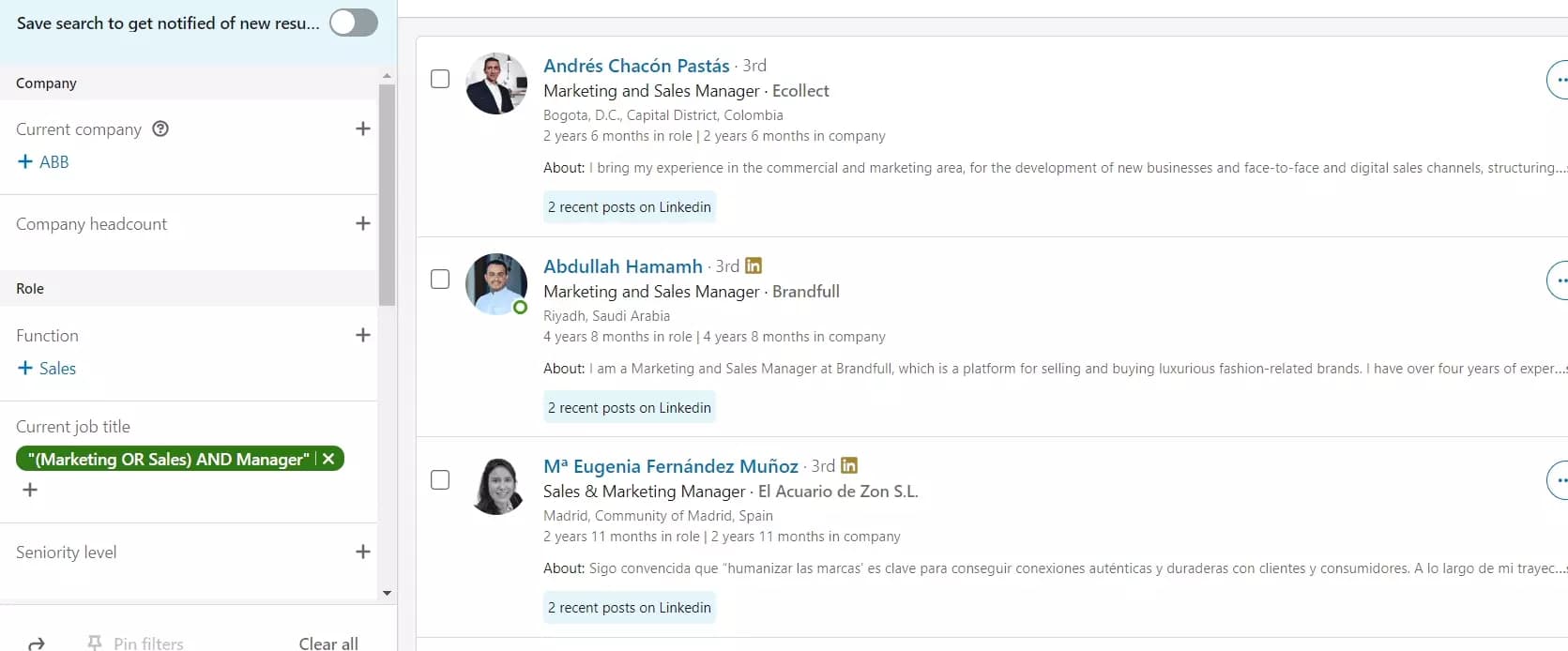
You can combine AND, OR, and NOT with parentheses to make your search even more specific.
For example, I want to find managers who work in either marketing or sales, but I don’t want to include social media marketing managers:
Example: "(Marketing OR Sales) AND Manager" NOT Social Mediaf
How about combining all of them?
For example, let’s say I want to search for senior-level managers in marketing or sales, but I don’t want to include entry-level roles like interns or assistants. I’d use a search like this:
Example: ("Marketing Director" OR "Sales Director" OR "Head of Marketing" OR "Head of Sales" OR "VP of Marketing" OR "VP of Sales") AND ("Digital Marketing" OR "Business Development") NOT ("Intern" OR "Junior" OR "Assistant" OR "Trainee")f
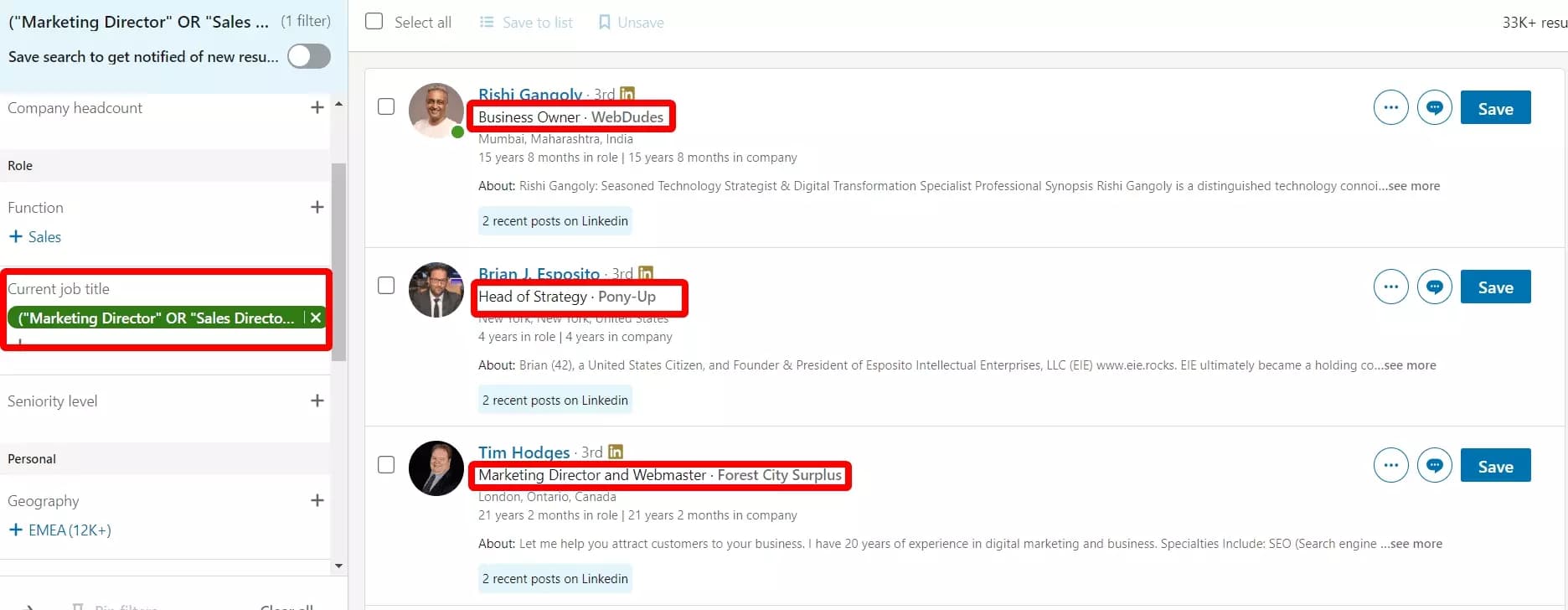
That’s how you use boolean search.
Now let’s spice it up a little bit. Let me add business consulting as industry and lead generation and data extraction software as category interests.
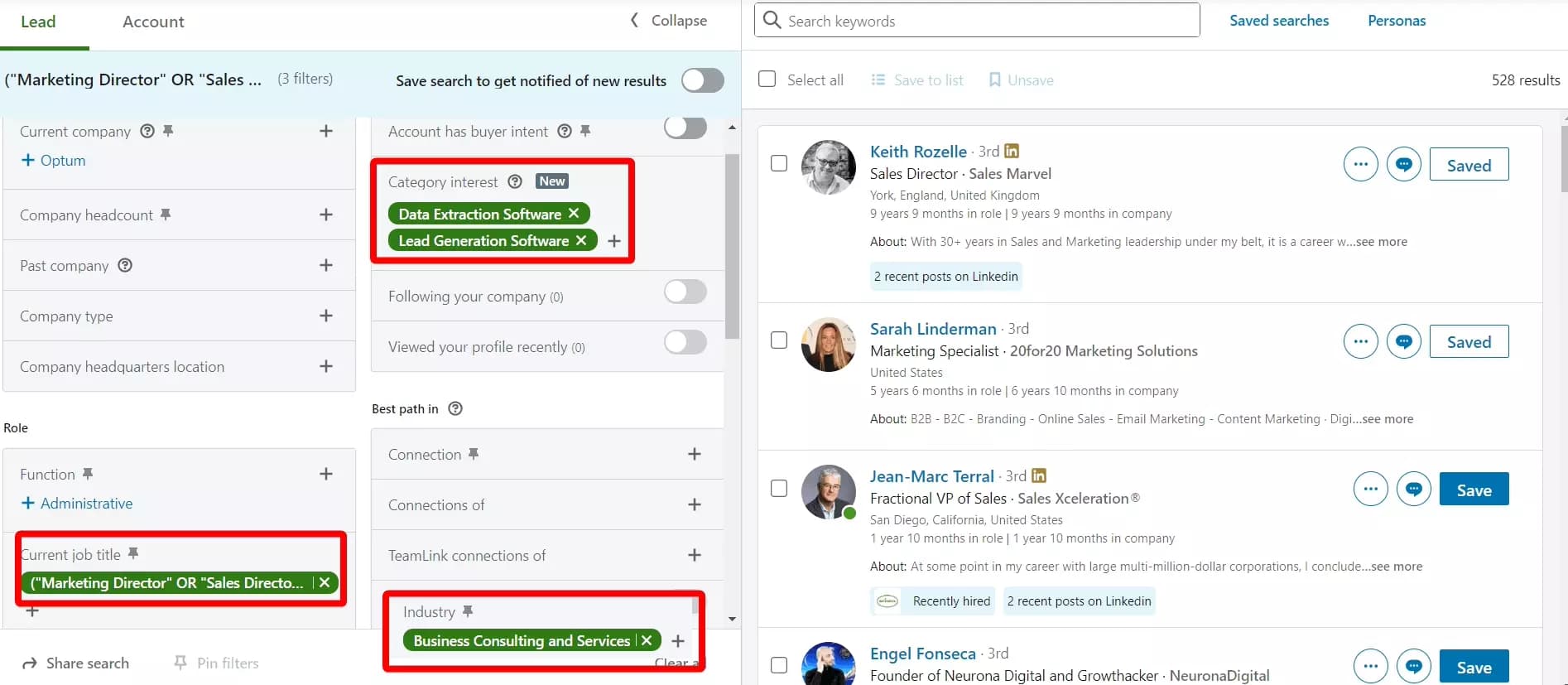
I have 500+ potential leads for B2B sales outreach that might be interested in data extraction or lead generation software.
I want to export them to a Google Sheet for an in-depth analysis. Can I do it directly from Sales Navigator? No!
But Lobstr.io can help you with that and much more.
How to use Lobstr.io to get the most out of LinkedIn Sales Navigator?
Lobstr.io is a French data scraping and automation company offering a wide range of automation and data collection tools, including Sales Navigator Leads Scraper.
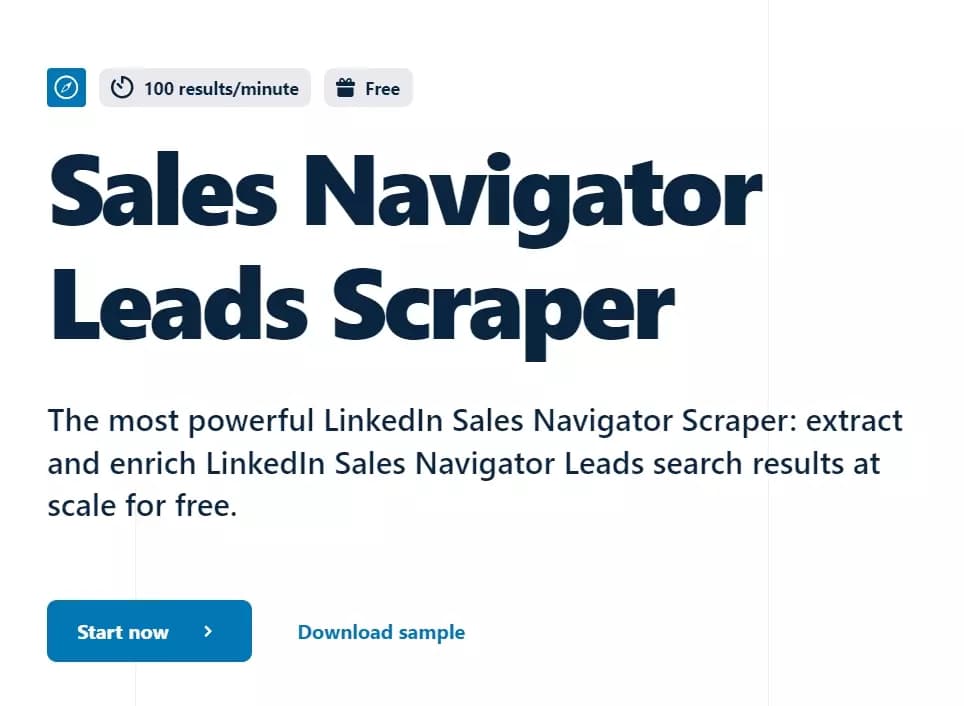
Here’s what Lobstr.io can do:
- Collect all leads from Sales Navigator search
- Scrape 25+ key data points from each profile
- Enrich data with verified emails
- Export all the data to CSV, Google Sheets and Amazon S3
- Automate data collection with scheduling
- API access to integrate scraper with your own apps and CRMs
But what does "enrich data with verified emails" mean?
Lobstr.io also offers a solid email discovery service.

- It finds public emails from LinkedIn profile
- If not present, it looks for work emails outside LinkedIn
- If not available, it uses an algorithm to guess work emails
- It then makes sure the emails are verified
But all this is going to take a lot of time right?
No, you can set up and launch the scraper in less than 2 minutes and it will start collecting up to 100 leads per minute for you.
All it takes is 5 simple steps:
- Create a Squid
- Paste Sales Navigator search URL
- Specify limits and what data to collect
- Connect a Google Sheet for auto data export
- Launch the scraper
Though you can’t export leads from Sales Navigator, you can save the search to get notified whenever there are new results.
How to use saved searches in Sales Navigator?
Saved searches let you save your search criteria so you don’t have to start from scratch every time.
Plus, you can set up alerts to get notified when new leads match your saved search filters.

You can use saved searches to keep track of specific types of leads or accounts without having to repeat the same steps.
Another amazing feature is lead recommendations.
How do lead recommendations work?
Sales Navigator uses your past searches, saved leads, and account interactions to recommend new prospects.
It looks at things like job titles, industries, and company sizes similar to those you've already targeted.
You can find recommended leads by going to the Leads tab and clicking on the recommended leads section.
So far, I've only covered different aspects of Sales Navigator search.
But that's just collecting data.
What about approaching those potential prospects and converting cold leads into warm leads or even customers?
Let's discuss some ways to do that.
How to reach out to your Sales Navigator leads?
Well typically there are 3 ways to reach out to your potential leads:
Let me give you a short overview of each of them.
How to send connection requests to Sales Navigator leads?
Sending a connection request is the easiest way to start a conversation on LinkedIn.
You can send connection requests to any lead in 3 simple steps:
- Click the 3 dots (...) next to the profile
- Click Connect and type your message
- Now click Send Invitation
But don’t just hit "Send Invitation" without adding a message!
Personalize it. Mention something you have in common or refer to a recent post of theirs to get their attention.
Better follow these tips for sending personalized connection requests.
- Keep it short and personal—don’t use the generic connection message
- Mention something you share, like a group, connection, or interest
- Don’t pitch right away. Focus on connecting, not selling
But what if I have to send 100 connection requests?
Well, you can't do it directly from the Sales Navigator as it allows you to send one request at a time.
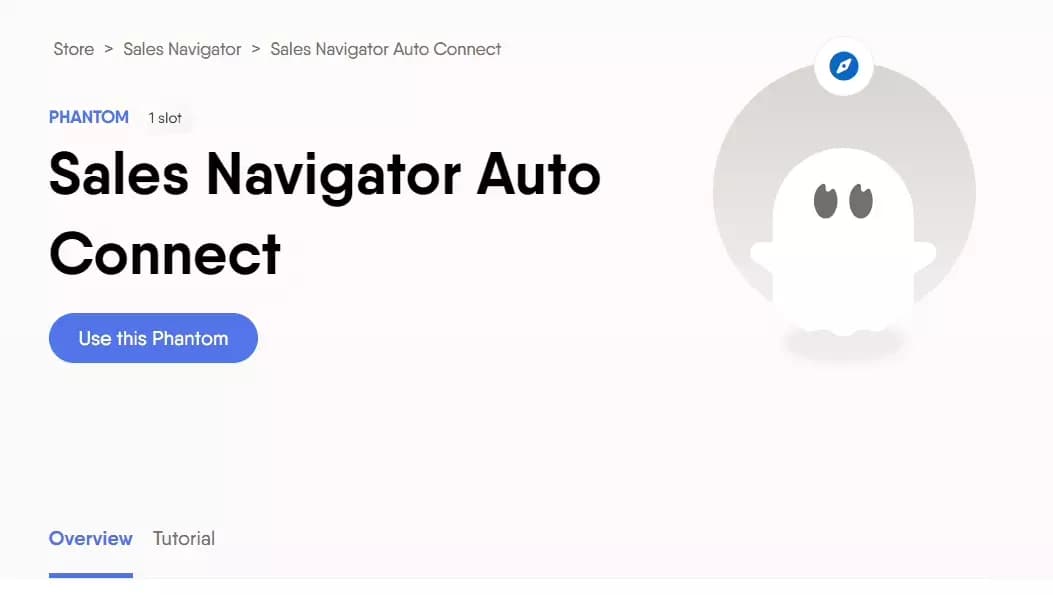
It also allows you to personalize your messages to some extend.
But remember, you are limited to 100 connection requests per week.
How to send InMail messages to Sales Navigator leads?
InMail is perfect for reaching out to people you aren’t connected with. It gives you direct access to their inbox.
It only takes 3 simple steps to send an InMail.
- Click the message icon (💬) next to a profile
- Type the subject line and message text
- Click Send button
You can also attach SmartLinks to your InMail messages for tracking.
But keep in mind, personalization is key.
No one likes a spammy, generic message. Try these tips for better response.
- Start with something personal—comment on a recent update or something in their profile
- Make your message valuable—show them what’s in it for them
- Keep it short and sweet—people are busy and appreciate direct messages
But remember, you can send 50 InMail messages per month.
How to send cold emails to Sales Navigator leads?
Since connection requests and InMail have limitations, the best choice for bulk outreach is cold emails.
Cold emails are a great way to reach leads outside of LinkedIn, especially those who prefer email over LinkedIn messages.
But Sales Navigator doesn't provide email addresses, how can I send cold emails if I don't have emails?
As I explained earlier, you can use it to collect verified professional emails of your potential leads.
But you need to personalize your cold emails before sending them. Follow these tips to get better response.
- Start with a strong subject line and a personalized opener to grab their attention
- Focus on value—what can you offer them that solves their problem?
- Always follow up if they don’t reply right away. Sometimes it takes a nudge to get a response
But Sales Navigator is not perfect.
Let me highlight some common problems and limitations.
Problems and limitations of Sales Navigator
Most common problem I found online is "Too Many Requests" issue.
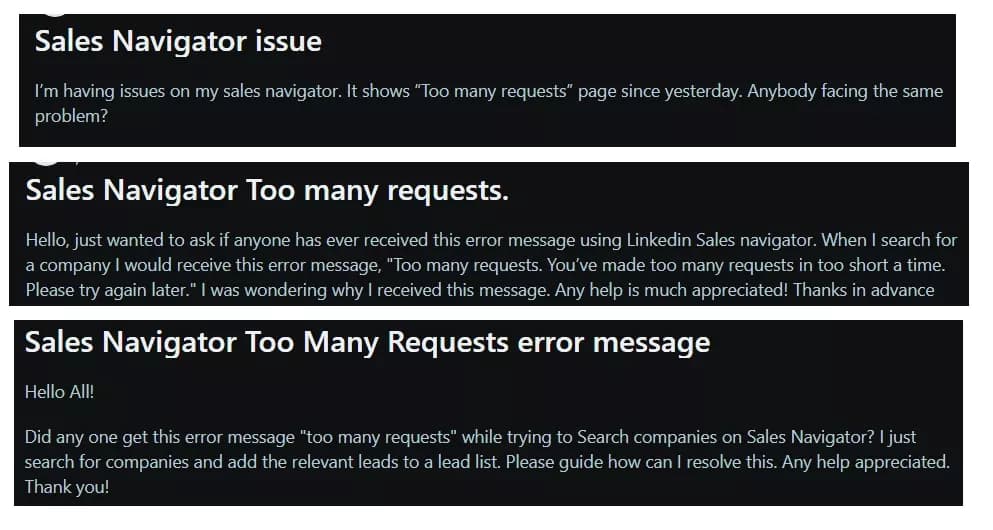
The "Too Many Requests" issue in Sales Navigator pops up when you make too many searches or profile views in a short time.
When you hit the limit, you'll see an error that says, "Too Many Requests", and you won’t be able to search or view profiles until the limit resets.
Typically, you might have to wait a few hours or up to a day for access to be restored.
If you’re using Lobstr.io, you can solve this issue by adjusting the limits.
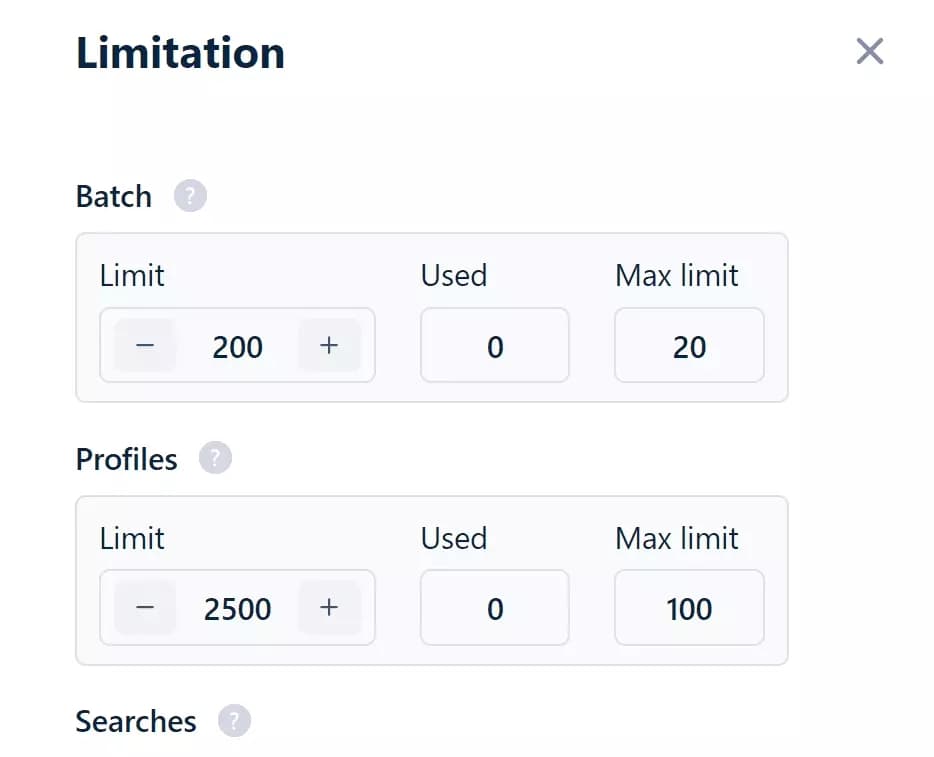
Sales Navigator doesn’t limit the number of searches but it does limit the number of results you can view per search.
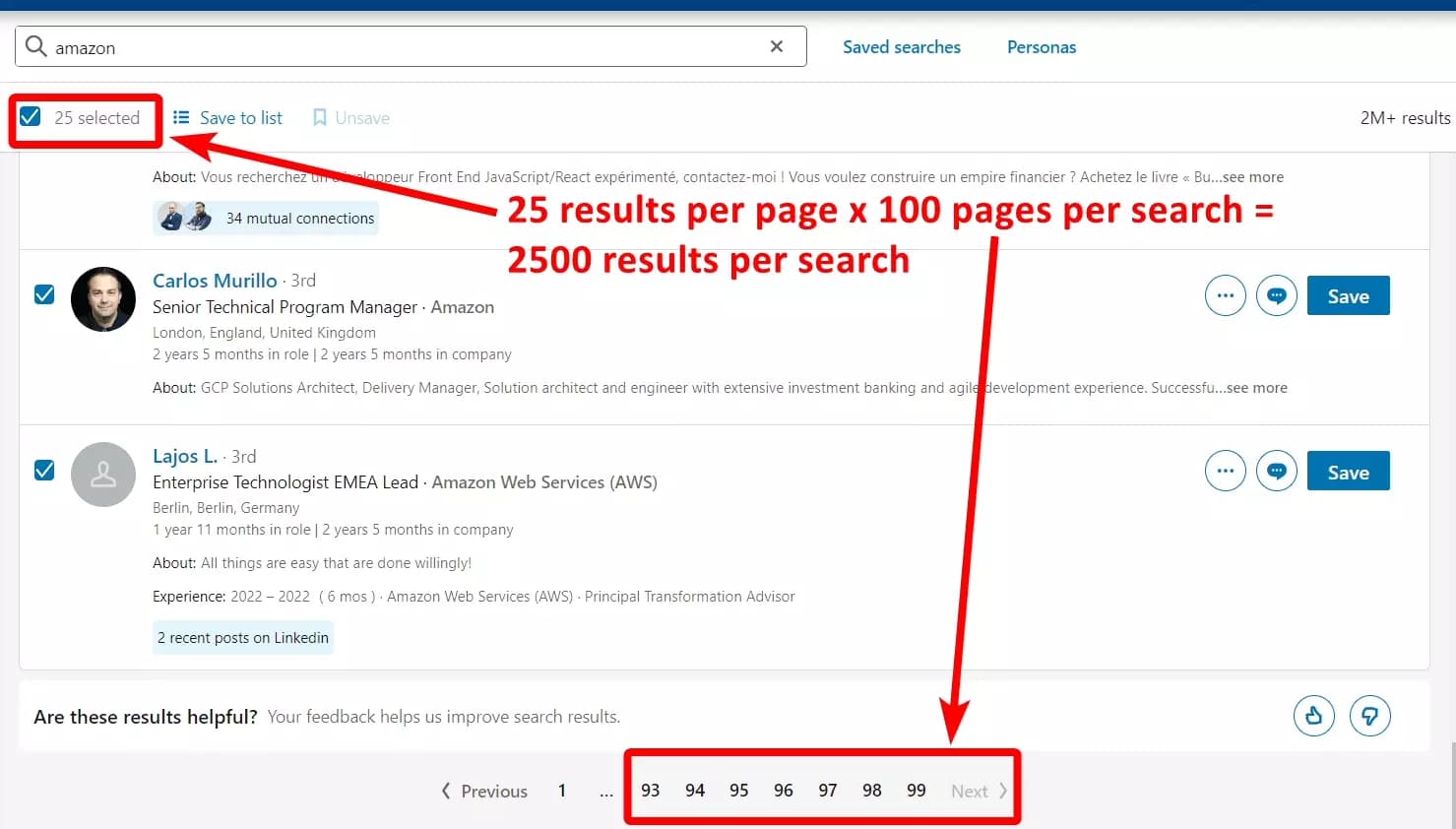
You can only see 2500 results per search in Sales Navigator.
But with Lobstr.io, you can bypass this limitation too.
Just split your single search into multiple searches and add all URLs to Lobstr.io and it’ll collect all the results for you.
Now let’s address some common mistakes people make.
5 common mistakes people make while using Sales Navigator
After spending some time analyzing problems, I also found some common mistakes.
Below are 5 most common mistakes people make while using Sales Navigator.
- Expecting inbound leads
- Not setting up Personas
- Using Personas in general searches
- Not using lists
- Ignoring alerts
Sales Navigator doesn’t automatically bring leads to you. It’s an outbound tool, so you need to actively engage and pursue prospects to start conversations.
Not creating personas means you’re missing out on more focused searches. Personas help tailor your outreach.
Also while personas are great for specific account targeting, they can limit your results in general searches.
Use them wisely and rely on advanced search filters for broader searches.
Saving leads without categorizing them into lists makes managing prospects harder. Lists help you stay organized and keep track of who to prioritize.
Alerts notify you of important updates, like job changes or posts from your leads. Ignoring them means missing out on easy opportunities to start conversations.
That’s pretty much it.
FAQs
Do I need LinkedIn Premium if I have Sales Navigator?
No, you don’t need LinkedIn Premium if you have a Sales Navigator account. In fact LinkedIn Premium is included in your Sales Navigator subscription.
What are the top benefits of LinkedIn Sales Navigator?
With LinkedIn Sales Navigator, you can boost your social selling by easily finding relevant leads through advanced filters.
It helps you perform detailed account searches and stay updated with real-time info, speeding up your sales cycle.
Plus, you can reach out to prospects beyond your network using InMail.
What is InMail?
InMail is LinkedIn’s way of letting you send messages to people you’re not connected with.
It’s perfect for reaching out to prospects outside your network and starting direct conversations
Is LinkedIn sales Navigator a CRM?
No, LinkedIn Sales Navigator is not a CRM. It helps sales reps find their target audience using advanced search features.
It does offer CRM integration to enterprises with its Advanced Plus subscription plan.
How to use Linkedin sales navigator to find a job?
You can use account filters for job hunting. Company attributes like headcount growth and spotlight filters can help you find a job.
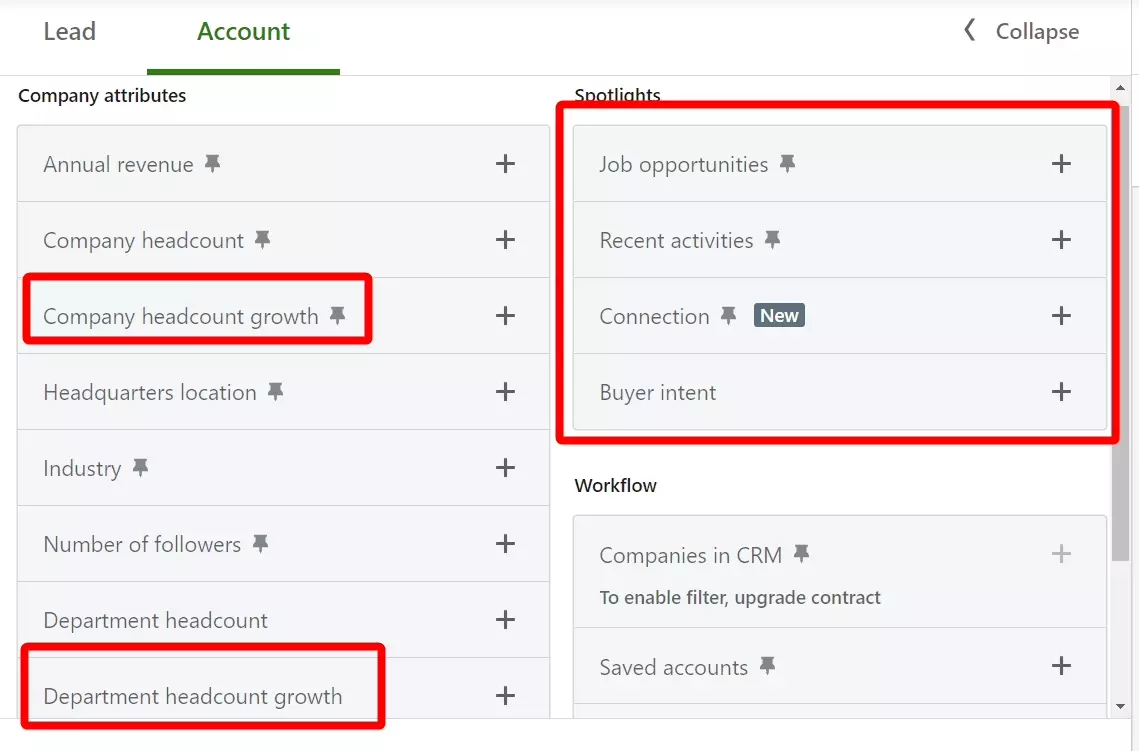
But its main purpose is still LinkedIn lead generation.
How can I reach out to leads I collect from Sales Navigator?
You can send connection requests or InMail messages to LinkedIn profiles for outreach. Make sure to send follow-ups too.
If you’re using Lobstr.io, you also get your prospect’s work email that you can use for cold outreach.
Conclusion
That’s a wrap on how to use LinkedIn Sales Navigator to generate leads in 2024. Try Sales Navigator Leads Scraper for automated lead collection at scale.
